Stewart
Harv's Norman supercharger thread
-
parisian62
- Posts: 3997
- Joined: Wed May 11, 2005 2:19 pm
- State: NSW
- Location: Sydney
- Contact:
Re: Harv's Norman supercharger thread
Wow. All those Normans superchargers.  Maybe get a photo of all of them in the one shot Andrew? That would look
Maybe get a photo of all of them in the one shot Andrew? That would look 
Stewart
Stewart
Feelin free in a '61 FB.
Member of FB-EK Holden Car Club Of NSW Inc.
Check out the Rebuild of Old Timer
Member of FB-EK Holden Car Club Of NSW Inc.
Check out the Rebuild of Old Timer
Re: Harv's Norman supercharger thread
Orright, time for a post with a bit more substance (the pictures were nice, but a bit light and fluffy  ). This time around I'll deal with capacity.
). This time around I'll deal with capacity.
The capacity of a sliding vane compressor is determined by how much air the compressor sucks in between two consecutive vanes. In the image below, the compressor rotor has just turned to the point that the inlet port has been sealed off, trapping the air in the space shown in red.
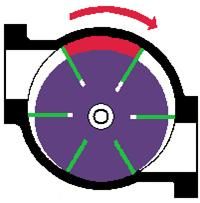
This volume of air, measured in cubic inches, is the volume of the air that one vane carries around per revolution. By multiplying by the number of vanes, the compressor capacity per revolution is determined. To measure this capacity on Norman superchargers, the end plate can be removed and the rotor turned by hand to the position shown. By using a pencil and paper, a rubbing of the area shown in red can be taken. The rubbing can then be ruled up with a grid of squares (say ¼”x¼”, where each square = 1/8 inch2), and the squares counted to estimate the area. By multiplying the area by both the length of the rotor and the number of rotors, the compressor capacity per revolution is determined.
As examples, the Norman superchargers in my photos above have the following capacities:
Harv’s small Norman:
area of rubbing (by counting squares) = 2,261mm2
volume per rotor = 2,261mm2 x 150mm rotor depth = 339,150mm3
volume of supercharger = 339,150mm3 x 4 vanes = 1,356,000mm3 = 83ci
Harv’s large Norman:
area of rubbing (by counting squares) = 2,435mm2
volume per rotor = 2,435mm2 x 298mm rotor depth = 725,630mm3
volume of supercharger = 725,630mm3 x 3 vanes = 2,176,890mm3 = 133ci.
Harv’s water cooled Norman:
area of rubbing (by counting squares) = 1,717mm2
volume per rotor = 1,717mm2 x 345mm rotor depth = 592,365mm3
volume of supercharger = 592,365mm3 x 4 vanes = 2,369,460mm3 = 145ci
Gary’s Type 65 Norman:
area of rubbing (by counting squares) = 1,917mm2
volume per rotor = 1,917mm2 x 10” rotor depth = 486,918mm3
volume of supercharger = 486,918mm3 x 4 vanes = 1,947,672mm3 = 118ci
Gary’s large Norman:
area of rubbing (by counting squares) = 3,233mm2
volume per rotor = 3,233mm2 x 347mm rotor depth = 1,121,851mm3
volume of supercharger = 1,121,851mm3 x 3 vanes = 3,365,000mm3 = 205.4ci
Comparing this to some common superchargers:
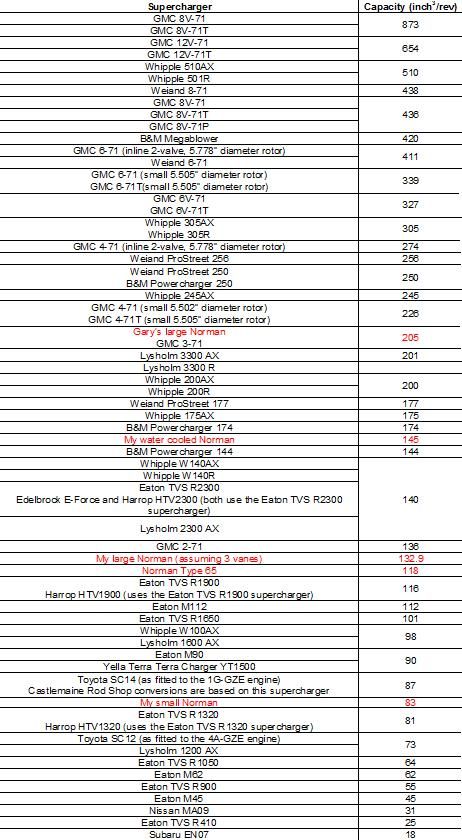
It is interesting to compare the Eaton M90 (as fitted to Holden Commodore VS (series II), VT, VX, VY L67 3800cc supercharged V6 engines) to the Norman superchargers… kind of like comparing Holden’s newest and oldest. The Eaton M90 capacity (90ci/rev) is almost the same capacity as my small Norman (83ci/rev), and only half the size of Gary’s large Norman (205ci/rev). However, capacity is also a function of how fast you can turn the supercharger. The Eaton M90 (generation 5) highest efficiency is at 6000rpm, with the flow map going out to 13,500rpm (there appears to be no real redline for the Eaton, but efficiency drops off pretty smartly). http://www.eaton.com/ecm/groups/public/ ... 128485.gif By By comparison, the Norman supercharger as fitted to a grey motor is typically driven at engine speeds of maximum 4500rpm. This means that although the capacities are about the same, you can run a new Commodore supercharger about twice as fast and hence get around double the capacity (i.e. the new Commodore superchargers have about the same realistic capacity as Gary’s large Norman, and about double the capacity of the old grey motor Normans). Similarly, then Toyota SC14 (as fitted to the 1G-GZE engine) ran at 1.25 times crank speed, with a (crank) redline of 7500rpm. This gives a blower redline around 9500rpm, and hence an overall capacity similar to the Eaton M90.
Sadly, I am not able to compare the capacity of the Norman’s to their sister supercharger, the Judson (sorry Al). Despite quite some searching and conversations with some Judson gurus, it appears that no-one has measured the capacities of these superchargers. The closest I can come is the smaller Judson was 5.125” X 4" diameter and was used on engines from 850 to 1300cc, whilst the larger Judson was 9.5 X 4"diameter, and was used on displacements from 1500 to 2500cc. Each used a 3" diameter rotor with 4 vanes.
Cheers,
Harv
The capacity of a sliding vane compressor is determined by how much air the compressor sucks in between two consecutive vanes. In the image below, the compressor rotor has just turned to the point that the inlet port has been sealed off, trapping the air in the space shown in red.

This volume of air, measured in cubic inches, is the volume of the air that one vane carries around per revolution. By multiplying by the number of vanes, the compressor capacity per revolution is determined. To measure this capacity on Norman superchargers, the end plate can be removed and the rotor turned by hand to the position shown. By using a pencil and paper, a rubbing of the area shown in red can be taken. The rubbing can then be ruled up with a grid of squares (say ¼”x¼”, where each square = 1/8 inch2), and the squares counted to estimate the area. By multiplying the area by both the length of the rotor and the number of rotors, the compressor capacity per revolution is determined.
As examples, the Norman superchargers in my photos above have the following capacities:
Harv’s small Norman:
area of rubbing (by counting squares) = 2,261mm2
volume per rotor = 2,261mm2 x 150mm rotor depth = 339,150mm3
volume of supercharger = 339,150mm3 x 4 vanes = 1,356,000mm3 = 83ci
Harv’s large Norman:
area of rubbing (by counting squares) = 2,435mm2
volume per rotor = 2,435mm2 x 298mm rotor depth = 725,630mm3
volume of supercharger = 725,630mm3 x 3 vanes = 2,176,890mm3 = 133ci.
Harv’s water cooled Norman:
area of rubbing (by counting squares) = 1,717mm2
volume per rotor = 1,717mm2 x 345mm rotor depth = 592,365mm3
volume of supercharger = 592,365mm3 x 4 vanes = 2,369,460mm3 = 145ci
Gary’s Type 65 Norman:
area of rubbing (by counting squares) = 1,917mm2
volume per rotor = 1,917mm2 x 10” rotor depth = 486,918mm3
volume of supercharger = 486,918mm3 x 4 vanes = 1,947,672mm3 = 118ci
Gary’s large Norman:
area of rubbing (by counting squares) = 3,233mm2
volume per rotor = 3,233mm2 x 347mm rotor depth = 1,121,851mm3
volume of supercharger = 1,121,851mm3 x 3 vanes = 3,365,000mm3 = 205.4ci
Comparing this to some common superchargers:

It is interesting to compare the Eaton M90 (as fitted to Holden Commodore VS (series II), VT, VX, VY L67 3800cc supercharged V6 engines) to the Norman superchargers… kind of like comparing Holden’s newest and oldest. The Eaton M90 capacity (90ci/rev) is almost the same capacity as my small Norman (83ci/rev), and only half the size of Gary’s large Norman (205ci/rev). However, capacity is also a function of how fast you can turn the supercharger. The Eaton M90 (generation 5) highest efficiency is at 6000rpm, with the flow map going out to 13,500rpm (there appears to be no real redline for the Eaton, but efficiency drops off pretty smartly). http://www.eaton.com/ecm/groups/public/ ... 128485.gif By By comparison, the Norman supercharger as fitted to a grey motor is typically driven at engine speeds of maximum 4500rpm. This means that although the capacities are about the same, you can run a new Commodore supercharger about twice as fast and hence get around double the capacity (i.e. the new Commodore superchargers have about the same realistic capacity as Gary’s large Norman, and about double the capacity of the old grey motor Normans). Similarly, then Toyota SC14 (as fitted to the 1G-GZE engine) ran at 1.25 times crank speed, with a (crank) redline of 7500rpm. This gives a blower redline around 9500rpm, and hence an overall capacity similar to the Eaton M90.
Sadly, I am not able to compare the capacity of the Norman’s to their sister supercharger, the Judson (sorry Al). Despite quite some searching and conversations with some Judson gurus, it appears that no-one has measured the capacities of these superchargers. The closest I can come is the smaller Judson was 5.125” X 4" diameter and was used on engines from 850 to 1300cc, whilst the larger Judson was 9.5 X 4"diameter, and was used on displacements from 1500 to 2500cc. Each used a 3" diameter rotor with 4 vanes.
Cheers,
Harv
327 Chev EK wagon, original EK ute for Number 1 Daughter, an FB sedan meth monster project and a BB/MD grey motored FED.
Re: Harv's Norman supercharger thread
A good read thanks Harv. Much appreciated and enjoyed 
Alan
Member No.1 of the FB EK Holden Car Club of WA (Woo-hoo sweet!)
sweet!)
Member No.1 of the FB EK Holden Car Club of WA (Woo-hoo
Re: Harv's Norman supercharger thread
Having looked at the capacity (flow) of Norman superchargers in the last post, it's time to think about pressure.
The efficiency of a sliding vane compressor is dependent on whether the machine has an internal compression ratio or not. Where the sliding vane compressor rotor is mounted centrally (like in air tools), we have no internal compression ratio. As an example, assume the centrally-mounted supercharger is delivering 5 psi of boost, as shown below.
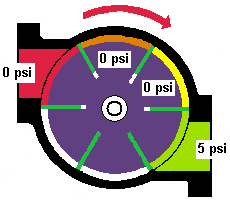
Because the compressor does not compress the air inside the casing, the 0 psi inlet pressure is also seen in the orange and yellow areas of the casing. As the yellow area of the casing is spun around to the green outlet, 0 psi air from the casing meets 5 psi air from the inlet manifold. The manifold initially flows air backwards into the supercharger casing, until the rotating vanes smoosh the air into the inlet manifold and compress it to 5 psi. This backwards and forwards flow reduces the compressor efficiency substantively, the same way that a Rootes compressor behaves. In the case of the Rootes compressor, this is one of the main reasons why Rootes compressor efficiency is low (around 55%) compared to centrifugal compressors (around 70%).
Sliding vane compressors having an internal pressure ratio (where the sliding vane compressor rotor is mounted eccentrically, like Norman superchargers) have a higher efficiency than the example shown above. This is because the compressed air delivered from the casing does not flow backwards and forwards as it exits the exhaust port. However, the efficiency is also dependent on the location of the exhaust port. Ideally, the compressor should deliver the required boost pressure at the outlet (i.e. if we want 5 psi boost, that is exactly what gets spat out of the supercharger). Using our example from above of a compressor delivering 5 psi of boost, but assume an eccentric mounted compressor like the Norman. The image below shows how the pressure increases inside the casing.
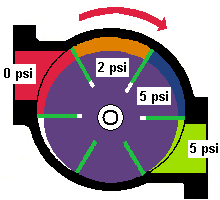
As the blue area of the casing is spun around to the green outlet, 5 psi air from the casing meets 5 psi air from the inlet manifold, and no energy is lost in backwards and forwards flow.
However, if the discharge port is located closer to the inlet side (as per the diagram below), the compressor may not deliver the same pressure as the required boost pressure.
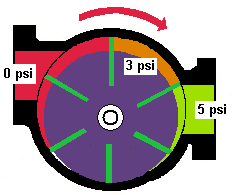
Whilst the gas is squeezed, the space it is being squeeze into (the orange area) is not yet small enough to increase pressure to our 5 psi desired example pressure… in the example we are only getting 3 psi. In this case, there will be some backwards and forwards flow during discharge (when the 3psi orange area opens up to the 5psi green area), and a resultant loss of efficiency.
Similarly, if the compressor discharge port is located further away from the inlet side (as per the diagram below), the gas is squeezed more than is required for boost pressure.
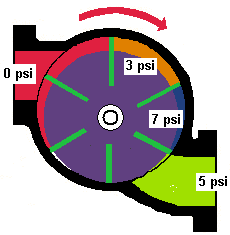
As the compressor begins to discharge, the gas expands into the inlet manifold. In the example above, the gas is compressed to 7 psi (blue area) before expanding into the (green) 5 psi discharge port. This “over-compressing and expansion” is again inefficient.
The chart below (which I have adapted from Compressors Selection and Sizing by Royce Brown) shows two cases – either the discharge port being too close to the inlet, or too far from the inlet. The red area under the chart represents the energy lost (leading to lower efficiency) in each case.
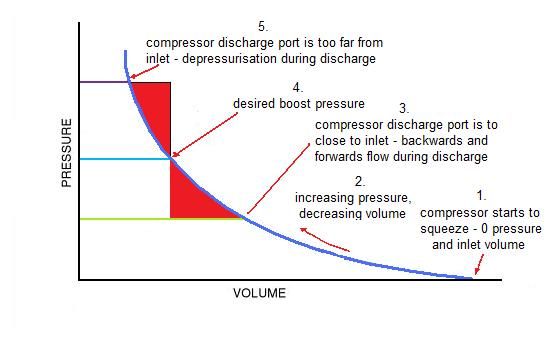
Looking at one parcel of air (between two adjacent vanes) moving through the supercharger, and targeting a boost pressure as shown at 4.:
1. We start with the supercharger sucking in air from the inlet manifold. We have zero pressure (just atmospheric pressure), and the air takes up just the inlet volume between the two adjacent vanes.
2. The rotor spins and we start compressing our parcel of air. Volume decreases and pressure increases.
3. If the compressor discharge port is designed to open at this point, we haven’t squeezed up to the pressure at 4. yet. Our air flows backwards and forwards during discharge, and we lose the energy shown in the lower red triangle.
4. If we keep squeezing (rotating), and our discharge port is positioned so the air is released at this pressure, then we are optimized. Nice smooth flow from the supercharger into the cylinder head.
5. If we still keep squeezing (rotating), and our discharge port is positioned at this pressure, then we have overcompressed. Our air will lose pressure once it is released into the cylinder head, and we lose the energy shown by the upper red triangle.
OK, enough for one post. Next post we will see how to measure up an actual Norman supercharger, and then how to work out what the optimal discharge pressure is for that machine.
Cheers,
Harv (deputy apprentice Norman supercharger fiddler).
The efficiency of a sliding vane compressor is dependent on whether the machine has an internal compression ratio or not. Where the sliding vane compressor rotor is mounted centrally (like in air tools), we have no internal compression ratio. As an example, assume the centrally-mounted supercharger is delivering 5 psi of boost, as shown below.

Because the compressor does not compress the air inside the casing, the 0 psi inlet pressure is also seen in the orange and yellow areas of the casing. As the yellow area of the casing is spun around to the green outlet, 0 psi air from the casing meets 5 psi air from the inlet manifold. The manifold initially flows air backwards into the supercharger casing, until the rotating vanes smoosh the air into the inlet manifold and compress it to 5 psi. This backwards and forwards flow reduces the compressor efficiency substantively, the same way that a Rootes compressor behaves. In the case of the Rootes compressor, this is one of the main reasons why Rootes compressor efficiency is low (around 55%) compared to centrifugal compressors (around 70%).
Sliding vane compressors having an internal pressure ratio (where the sliding vane compressor rotor is mounted eccentrically, like Norman superchargers) have a higher efficiency than the example shown above. This is because the compressed air delivered from the casing does not flow backwards and forwards as it exits the exhaust port. However, the efficiency is also dependent on the location of the exhaust port. Ideally, the compressor should deliver the required boost pressure at the outlet (i.e. if we want 5 psi boost, that is exactly what gets spat out of the supercharger). Using our example from above of a compressor delivering 5 psi of boost, but assume an eccentric mounted compressor like the Norman. The image below shows how the pressure increases inside the casing.

As the blue area of the casing is spun around to the green outlet, 5 psi air from the casing meets 5 psi air from the inlet manifold, and no energy is lost in backwards and forwards flow.
However, if the discharge port is located closer to the inlet side (as per the diagram below), the compressor may not deliver the same pressure as the required boost pressure.

Whilst the gas is squeezed, the space it is being squeeze into (the orange area) is not yet small enough to increase pressure to our 5 psi desired example pressure… in the example we are only getting 3 psi. In this case, there will be some backwards and forwards flow during discharge (when the 3psi orange area opens up to the 5psi green area), and a resultant loss of efficiency.
Similarly, if the compressor discharge port is located further away from the inlet side (as per the diagram below), the gas is squeezed more than is required for boost pressure.

As the compressor begins to discharge, the gas expands into the inlet manifold. In the example above, the gas is compressed to 7 psi (blue area) before expanding into the (green) 5 psi discharge port. This “over-compressing and expansion” is again inefficient.
The chart below (which I have adapted from Compressors Selection and Sizing by Royce Brown) shows two cases – either the discharge port being too close to the inlet, or too far from the inlet. The red area under the chart represents the energy lost (leading to lower efficiency) in each case.

Looking at one parcel of air (between two adjacent vanes) moving through the supercharger, and targeting a boost pressure as shown at 4.:
1. We start with the supercharger sucking in air from the inlet manifold. We have zero pressure (just atmospheric pressure), and the air takes up just the inlet volume between the two adjacent vanes.
2. The rotor spins and we start compressing our parcel of air. Volume decreases and pressure increases.
3. If the compressor discharge port is designed to open at this point, we haven’t squeezed up to the pressure at 4. yet. Our air flows backwards and forwards during discharge, and we lose the energy shown in the lower red triangle.
4. If we keep squeezing (rotating), and our discharge port is positioned so the air is released at this pressure, then we are optimized. Nice smooth flow from the supercharger into the cylinder head.
5. If we still keep squeezing (rotating), and our discharge port is positioned at this pressure, then we have overcompressed. Our air will lose pressure once it is released into the cylinder head, and we lose the energy shown by the upper red triangle.
OK, enough for one post. Next post we will see how to measure up an actual Norman supercharger, and then how to work out what the optimal discharge pressure is for that machine.
Cheers,
Harv (deputy apprentice Norman supercharger fiddler).
327 Chev EK wagon, original EK ute for Number 1 Daughter, an FB sedan meth monster project and a BB/MD grey motored FED.
Re: Harv's Norman supercharger thread
One thing I noticed about my Judson is that there would be a vacuum created as the vanes travel from the 7 o'clock position towards the inlet. I would have put some shallow annular grooves into the bore to allow air to flow from the inlet to somewhere around the 8 o'clock position so that the vacuum would be relived (if you see what I mean). It wouldn't add anything to the 'efficiency' of the supercharger, but would possibly take less energy to drive it and result in less wear on the vanes and slots in the shaft.
I guess it might also cause less turbulence at the inlet and improve efficiency because air wouldn't be sucked downwards under vacuum temporarily robbing available air from the inlet.
The area that the vacuum would be created is where the words 'vane' and 'shaft' are in the picture that I stole off you below:
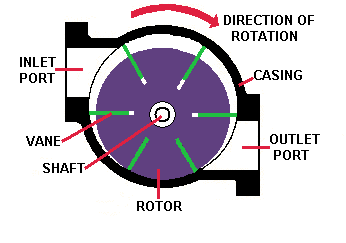
Maybe I should go back to 1950 and apply for a patent
Actually, second thoughts, the leading face of the vanes on the Judson have some shallow slots relieved into them. This means the vacuum would suck the vane back down into the slot breaking the vacuum. D'oh! There goes my patent
I guess it might also cause less turbulence at the inlet and improve efficiency because air wouldn't be sucked downwards under vacuum temporarily robbing available air from the inlet.
The area that the vacuum would be created is where the words 'vane' and 'shaft' are in the picture that I stole off you below:

Maybe I should go back to 1950 and apply for a patent
Actually, second thoughts, the leading face of the vanes on the Judson have some shallow slots relieved into them. This means the vacuum would suck the vane back down into the slot breaking the vacuum. D'oh! There goes my patent
Alan
Member No.1 of the FB EK Holden Car Club of WA (Woo-hoo sweet!)
sweet!)
Member No.1 of the FB EK Holden Car Club of WA (Woo-hoo
Re: Harv's Norman supercharger thread
As promised, time to see just what pressure the Normans are designed for 
For an existing Norman supercharger, the discharge port is fixed. We can then measure and calculate the compressor internal compression ratio, and can estimate the boost pressure which is optimal for the specific port location. To do this, we need:
a) the inlet air volume, which we determined in the last post by using the pencil rubbing technique. This area is shown in the diagram below red,
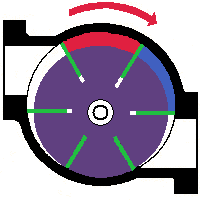
b) the inlet air temperature (this is the normal outside air temperature).
c) the discharge air volume. In the image above, the compressor rotor has just turned to the point that the discharge port is just about to be exposed, with the air trapped in the space shown in blue. This volume of air, measured in cubic inches, is the discharge air volume. To measure this capacity on Norman superchargers, the end plate can be removed and the rotor turned by hand to the position shown. By using a pencil and paper, a rubbing of the area shown in red can be taken (just like we did with the inlet volume). The rubbing can then be ruled up with a grid of squares (say ¼”x¼”, where each square = 1/8 inch2), and the squares counted to estimate the area. By multiplying the area by the length of the rotor and by the number of rotors, the compressor discharge air volume is determined.
d) The discharge air temperature. This can be calculated for different boost levels by a convoluted process. I will cover this in a future post.
The pressures we will use for the calculations need to be in absolute pressure terms. This is achieved by taking the boost pressure (the pressure you would read on a gauge screwed into the inlet manifold) and adding 14.7 psi. For example, atmospheric pressure (0 psi boost) is (0 + 14.7 =) 14.7 psiabsolute. Similarly, the temperatures above need to be in absolute temperature terms. This is achieved by taking the normal temperature (the temperature you would read on a temperature gauge screwed into the inlet manifold), and adding 273ºC. For example, 35ºC temperature is (35 + 273 =) 308ºabsolute.
We can then use the equation below to determine the optimum boost pressure for a given Norman supercharger:
(inlet pressure x inlet air volume)/(inlet air temperature x discharge air volume)= (discharge pressure)/(discharge air temperature)
Note that whilst the above process can be used to find the optimum (most efficient) operating pressure for a given sliding vane compressor, it does not preclude the supercharger being run at lower or higher boost… it just means that the compressor will not run as efficiently.
As an example, consider my small Norman. For this supercharger, the inlet and discharge air volumes (calculated by the pencil rubbing technique) are as follows:
a) Inlet air volume = 83 inchs3/revolution, and
b) Discharge air volume = 73 inchs3/revolution.
As an aide, notice that the discharge air volume is less than the inlet air volume - this particular supercharger, like all Normans, has an internal compression ratio (the air/fuel mixture is getting squeeeeeeeezed inside the supercharger).
We can then start calculating:
Inlet pressure = atmospheric pressure = 0 psi boost = (0 + 14.7) = 14.7 psiabsolute.
Inlet air temperature = atmospheric temperature = 35ºC = (35 + 273) = 308ºabsolute
Notice I am assuming a 35ºC day here… we could just of readily chosen a cooler day, but 35ºC is reasonable – a fairly hot day when the engine will be working hard even with a cold air intake. Without a cold air intake, the supercharger air inlet temperature (aka the under-bonnet temperature) can be significantly higher.
(Inlet pressure x inlet air volume)÷(inlet air temperature x discharge air volume) = (14.7x83)÷(308x73) = 0.0543
Discharge air temperature and discharge pressure are linked together, and can be modeled (we will do this in a later post… more on this later). If we assume that the motor is a typically asthmatic Holden grey motor (engine volumetric efficiency (VE) of 80%), that our Norman supercharger volumetric efficiency is 90% and that we still have a 35ºC day, then I can draw the following table:
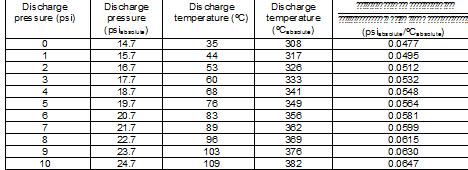
The right hand column calculates (discharge pressure/discharge air temperature)… sorry about the crappy label in the table.
Looking at the table above, we are looking for a value in the right hand column that is close to 0.0543. The table shows that this is around 3.7psi, inferring that the small Norman will run optimally at around this pressure (… for the curious, this would increase the factory EK Holden 75BHP by 25% to 94BHP, reducing the quarter mile from 18.7 to 17.3s). In practice, this means:
a) We could run the supercharger at less than 3.7psi boost (for example 3psi in the inlet manifold) using a given pulley size. The supercharger will work, but it will compress the air to 3.7 psi before it lets it out into the 3psi manifold. There will be some “popping” as this over-compressed air expands into the lower pressure inlet manifold, and some loss of efficiency.
b) We could run the supercharger at exactly 3.7psi boost, using a slightly larger smaller pulley (spin the supercharger faster). The air inside the compressor will be at 3.7psi when it lets out into the 3.7psi manifold. This is the most efficient operation.
c) We could run the supercharger at more than 3.7psi boost (for example 5psi in the inlet manifold) by using an even smaller pulley (spin the supercharger even faster). The air inside the compressor will be at 3.7 psi when it gets let out into the 5 psi manifold. There will be some popping as the manifold air backflows into the supercharger, before being pushed out again by the turning rotor and smooshed in the inlet manifold back up to 5psi. Again, some efficiency will be lost.
Repeating the above calculation process (pencil rubbings, calculations using the assumptions above, new table) for the other Normans:

Of note, the older Normans (those made by Eldred) are designed for much lower boost pressures than the later Normans (those made by Mike Norman). This aligns well to the common belief that the early grey motor Normans were low rev, low boost, standard engine machines. The larger, newer Normans are designed for much higher boost – probably due to advances in fuel quality, cylinder head flow, water/methanol injection and ignition that delay knocking and allowed them to deliver more power on red (and later) engines.
An interesting feature of the small Norman is that the two end plates have been drilled to allow them to be rotated 180º (some of the later Normans have a locating pin to prevent this). Rotating 180º puts the rotor offset to the other side of the casing, and changes the inlet and discharge air volumes.
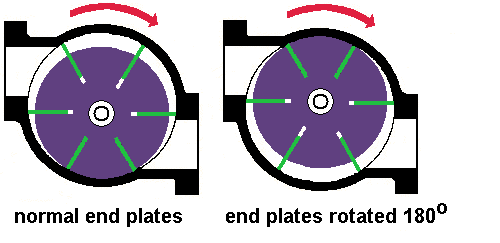
If end plates are rotated, the inlet air volume decreases from 83 to 24 inchs3/revolution and the discharge air volume decreases from 73 to 21 inchs3/revolution. This makes for a very small supercharger. If we undertake the same efficiency calculations:
(Inlet pressure x inlet air volume)÷(inlet air temperature x discharge air volume) = 0.0545
The table shows that this is around 3.8psi, inferring that the small Norman will run optimally at around this pressure… not much change from the other way the end plates were. However, we now would have a much smaller capacity, and would need to spin the supercharger much faster to feed a grey motor… supercharger speed goes from 4,000rpm to 14,000rpm. Whilst Eldred suggested a “destruction” speed of 19,000rpm for his superchargers (Australian Hot Rod, November 1966), this is an awful fast speed for a fifty year old piece of kit with rudimentary bearing thrust control… not for the faint hearted. The upshot here is that when overhauling the small Norman supercharger care needs to be taken to orient the end casings correctly.
Cheers,
Harv
For an existing Norman supercharger, the discharge port is fixed. We can then measure and calculate the compressor internal compression ratio, and can estimate the boost pressure which is optimal for the specific port location. To do this, we need:
a) the inlet air volume, which we determined in the last post by using the pencil rubbing technique. This area is shown in the diagram below red,

b) the inlet air temperature (this is the normal outside air temperature).
c) the discharge air volume. In the image above, the compressor rotor has just turned to the point that the discharge port is just about to be exposed, with the air trapped in the space shown in blue. This volume of air, measured in cubic inches, is the discharge air volume. To measure this capacity on Norman superchargers, the end plate can be removed and the rotor turned by hand to the position shown. By using a pencil and paper, a rubbing of the area shown in red can be taken (just like we did with the inlet volume). The rubbing can then be ruled up with a grid of squares (say ¼”x¼”, where each square = 1/8 inch2), and the squares counted to estimate the area. By multiplying the area by the length of the rotor and by the number of rotors, the compressor discharge air volume is determined.
d) The discharge air temperature. This can be calculated for different boost levels by a convoluted process. I will cover this in a future post.
The pressures we will use for the calculations need to be in absolute pressure terms. This is achieved by taking the boost pressure (the pressure you would read on a gauge screwed into the inlet manifold) and adding 14.7 psi. For example, atmospheric pressure (0 psi boost) is (0 + 14.7 =) 14.7 psiabsolute. Similarly, the temperatures above need to be in absolute temperature terms. This is achieved by taking the normal temperature (the temperature you would read on a temperature gauge screwed into the inlet manifold), and adding 273ºC. For example, 35ºC temperature is (35 + 273 =) 308ºabsolute.
We can then use the equation below to determine the optimum boost pressure for a given Norman supercharger:
(inlet pressure x inlet air volume)/(inlet air temperature x discharge air volume)= (discharge pressure)/(discharge air temperature)
Note that whilst the above process can be used to find the optimum (most efficient) operating pressure for a given sliding vane compressor, it does not preclude the supercharger being run at lower or higher boost… it just means that the compressor will not run as efficiently.
As an example, consider my small Norman. For this supercharger, the inlet and discharge air volumes (calculated by the pencil rubbing technique) are as follows:
a) Inlet air volume = 83 inchs3/revolution, and
b) Discharge air volume = 73 inchs3/revolution.
As an aide, notice that the discharge air volume is less than the inlet air volume - this particular supercharger, like all Normans, has an internal compression ratio (the air/fuel mixture is getting squeeeeeeeezed inside the supercharger).
We can then start calculating:
Inlet pressure = atmospheric pressure = 0 psi boost = (0 + 14.7) = 14.7 psiabsolute.
Inlet air temperature = atmospheric temperature = 35ºC = (35 + 273) = 308ºabsolute
Notice I am assuming a 35ºC day here… we could just of readily chosen a cooler day, but 35ºC is reasonable – a fairly hot day when the engine will be working hard even with a cold air intake. Without a cold air intake, the supercharger air inlet temperature (aka the under-bonnet temperature) can be significantly higher.
(Inlet pressure x inlet air volume)÷(inlet air temperature x discharge air volume) = (14.7x83)÷(308x73) = 0.0543
Discharge air temperature and discharge pressure are linked together, and can be modeled (we will do this in a later post… more on this later). If we assume that the motor is a typically asthmatic Holden grey motor (engine volumetric efficiency (VE) of 80%), that our Norman supercharger volumetric efficiency is 90% and that we still have a 35ºC day, then I can draw the following table:

The right hand column calculates (discharge pressure/discharge air temperature)… sorry about the crappy label in the table.
Looking at the table above, we are looking for a value in the right hand column that is close to 0.0543. The table shows that this is around 3.7psi, inferring that the small Norman will run optimally at around this pressure (… for the curious, this would increase the factory EK Holden 75BHP by 25% to 94BHP, reducing the quarter mile from 18.7 to 17.3s). In practice, this means:
a) We could run the supercharger at less than 3.7psi boost (for example 3psi in the inlet manifold) using a given pulley size. The supercharger will work, but it will compress the air to 3.7 psi before it lets it out into the 3psi manifold. There will be some “popping” as this over-compressed air expands into the lower pressure inlet manifold, and some loss of efficiency.
b) We could run the supercharger at exactly 3.7psi boost, using a slightly larger smaller pulley (spin the supercharger faster). The air inside the compressor will be at 3.7psi when it lets out into the 3.7psi manifold. This is the most efficient operation.
c) We could run the supercharger at more than 3.7psi boost (for example 5psi in the inlet manifold) by using an even smaller pulley (spin the supercharger even faster). The air inside the compressor will be at 3.7 psi when it gets let out into the 5 psi manifold. There will be some popping as the manifold air backflows into the supercharger, before being pushed out again by the turning rotor and smooshed in the inlet manifold back up to 5psi. Again, some efficiency will be lost.
Repeating the above calculation process (pencil rubbings, calculations using the assumptions above, new table) for the other Normans:

Of note, the older Normans (those made by Eldred) are designed for much lower boost pressures than the later Normans (those made by Mike Norman). This aligns well to the common belief that the early grey motor Normans were low rev, low boost, standard engine machines. The larger, newer Normans are designed for much higher boost – probably due to advances in fuel quality, cylinder head flow, water/methanol injection and ignition that delay knocking and allowed them to deliver more power on red (and later) engines.
An interesting feature of the small Norman is that the two end plates have been drilled to allow them to be rotated 180º (some of the later Normans have a locating pin to prevent this). Rotating 180º puts the rotor offset to the other side of the casing, and changes the inlet and discharge air volumes.

If end plates are rotated, the inlet air volume decreases from 83 to 24 inchs3/revolution and the discharge air volume decreases from 73 to 21 inchs3/revolution. This makes for a very small supercharger. If we undertake the same efficiency calculations:
(Inlet pressure x inlet air volume)÷(inlet air temperature x discharge air volume) = 0.0545
The table shows that this is around 3.8psi, inferring that the small Norman will run optimally at around this pressure… not much change from the other way the end plates were. However, we now would have a much smaller capacity, and would need to spin the supercharger much faster to feed a grey motor… supercharger speed goes from 4,000rpm to 14,000rpm. Whilst Eldred suggested a “destruction” speed of 19,000rpm for his superchargers (Australian Hot Rod, November 1966), this is an awful fast speed for a fifty year old piece of kit with rudimentary bearing thrust control… not for the faint hearted. The upshot here is that when overhauling the small Norman supercharger care needs to be taken to orient the end casings correctly.
Cheers,
Harv
327 Chev EK wagon, original EK ute for Number 1 Daughter, an FB sedan meth monster project and a BB/MD grey motored FED.
Re: Harv's Norman supercharger thread
For this post, I am going to deal with the lineup of the Norman supercharger, and most notably the issue of suck-through versus blow-through.
Superchargers are put together in two basic configurations:
a) Suck-Through: in this configuration the fuel source (normally a carburetor) is located upstream of the supercharger. The supercharger thus “sucks” the air through the carburetor. The carburetor has no idea that the supercharger exists – although the carburetor will need to flow more fuel/air to keep up with the extra engine power, it still operates under normal vacuum conditions just like a non-supercharged (naturally aspirated) engine. The supercharger in this case handles a mixture of fuel and air (i.e. an explosive air/fuel mixture exists all the way from the carburetor to the engine – all the items shown in red below).

b) Blow-Through: in this configuration the fuel source (a carburetor or fuel injection nozzles) are located downstream of the supercharger. The supercharger thus “blows” air through the carburetor. The carburetor now operates under positive pressure instead of vacuum, often requiring modification to the carburetor (which was designed to operate under engine vacuum). The supercharger in this case handles only air, and the amount of piping and equipment holding an explosive air/fuel mixture (marked in red below) is reduced.

Norman superchargers are normally configured as suck-through. We will now work through why thus is the case.
In very basic terms, we want to feed fuel and air into out engine in vast quantities. The image below shows the Norman supercharger connected up to the cylinder head of our Holden grey motor.
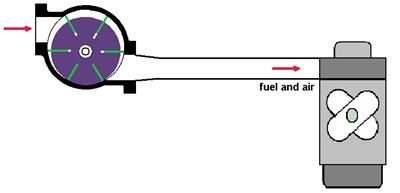
The first challenge that we face is that the supercharger internals have Bakelite vanes that rub against both the steel casing and the steel rotor slots. The vanes require lubrication to reduce the amount of friction (and hence vane wear). The incoming air does not do a great job of acting as a lubricant. We could add an oil squirter upstream of the supercharger, similar to the aftermarket squirter systems used to feed upper cylinder head lubricant (ValveMaster) when running unleaded fuel, or similar to the oilers used on workshop air tools. The image below shows this type of lineup. This type of squirter system, driven by engine vacuum, is commonly used on Judson sliding vane superchargers (the Marvel Mystery Oiler).
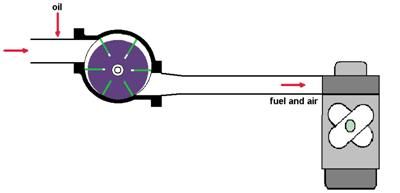
However, Eldred Norman found that this type of lubrication did not adequately lubricate the surfaces of the vanes in the rotor slots since centrifugal force tends to fling the oil drops against the casing. A better way of adding lubricant is to mix it in with the fuel. This oil/fuel mixture will then be fed much more evenly over the vanes. To do this, oil is added to the fuel tank (more on this later). By putting the carburetor upstream of the supercharger, the supercharger is fed both air and the fuel/oil mixture. The fuel/oil mixture then acts as a lubricant (and a heat sink) for the vanes. This lineup (suck-through) is shown in the image below.
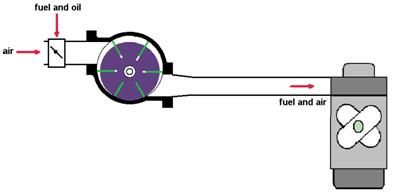
We will now talk through Norman supercharger control – and most notably the absence of Pssssshhht!
Norman superchargers in suck-through configuration do not need a blow-off valve (sometimes called a dump valve, or BOV). We will now work through why this is the case.
When the carburetor throttle plates are closed (for example during gear changes, as per the image below), the inlet air to the Norman supercharger is closed off.
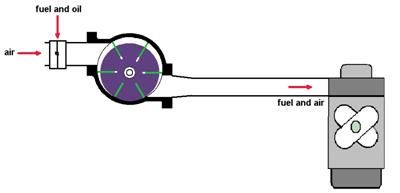
A slight vacuum will develop between the carburetor and the supercharger, though not a huge one. The supercharger inlet is not fed any air, and hence does not make a huge amount of pressure at the outlet. Boost remains (relatively) stable, and the supercharger does not see a huge load increase.
However, if a blow-through configuration had been utilized (as per the image below, shown with the throttle plate open) then a different phenomena occurs.
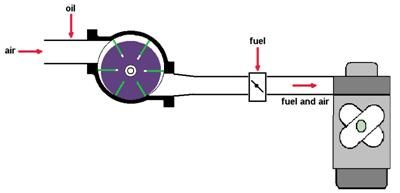
When the throttle plate closes, the supercharger has nowhere to discharge to. The inlet to the supercharger is still open, letting the machine suck in air. Because the Norman supercharger is a positive displacement machine, it will keep sucking in and compressing the air, mooshing it up against the closed throttle plate. The trapped boost pressure thus rises rapidly… giving the engine one hell of a shock once the throttle plate opens again. Worse, the supercharger goes into a high pressure, low flow situation called surge (this can sound like chattering in the machine). Surge causes damage to bearings and shafts.
To prevent surge, a blow-off valve would be required as shown in the image below.
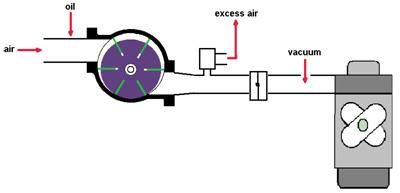
The blow-off valve is normally connected to the inlet manifold between the throttle plate and engine (I have not show this sensing line in the diagram for simplicity). When the throttle plate closes, our supercharger starts mooshing up boost against the closed plate. However, the inlet manifold between the throttle plate and engine goes into vacuum. The vacuum is sensed by the blow-off valve, which opens and lets out the excess air. In some cases the air is vented to atmosphere, giving the characteristic Pssssshhht! noise of late model turbo cars during gear changes. The loud noise of course is “very, very sexy mate”, and increases the libido. For those with no need for a libido increase, the blow-off valve can be plumbed back into the inlet manifold as shown in the image below.
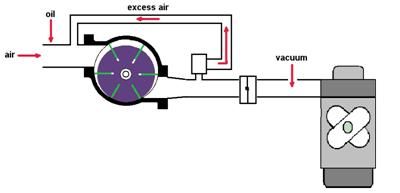
By venting off the excess air the supercharger can continue to spin and discharge. This prevents surge from happening. Many late-model vehicles run EFI, with the injection occuring after the supercharger (blow-through) and the throttle plate downstream of the supercharger. These vehicles are the ones commonly heard Psssssshhhhhting their way through traffic.
Blow-off valves are flow controllers – they are designed to ensure a minimum flow through the supercharger and prevent surge. Again, because we are running the Norman supercharger in a suck-through lineup a blow-off valve is not required. Note that a blow-off valve should not be confused with overpressure protection (burst panels or relief valves) which are required on Norman superchargers. We will deal with overpressure protection next.
As we have seen above, Norman superchargers are normally run in suck-through configuration, as per the images above. This means that all the equipment downstream of the carburetor contains an explosive air/fuel mixture – the carburetor-to-blower manifold, the Norman casing, any intercooler used and also the blower-to-cylinder head manifold. The large the amount or size of the equipment, the greater amount of fuel/air mixture and hence the greater potential for an explosion. The ANDRA General Regulations refer to this as Banging the Blower – “an explosion inside the supercharger caused by a flame from the combustion process accidentally re-entering the supercharger, where fuel and air are present. Generally caused by a stuck or broken intake valve that normally would be closed during the combustion sequence”. The more extreme the valve timing (more overlap) the more likely it is that the blower will bang, particularly at low rpm.
Banging the blower can lead interconnecting hoses blowing off, manifold gaskets being blown out and stalling of the supercharger (which can snap vanes and bend rotors). In extreme cases the supercharger can be blown clear off the manifold… one of the reasons that blower restraints are used in some classes of racing.
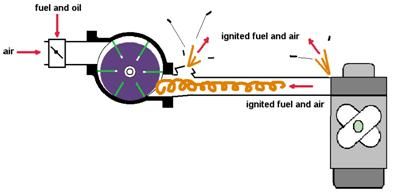
Belt drives are often used in Norman superchargers as they prevent a blower bang from stalling the crankshaft (they tend to slip instead). Given the risk involved, some form of overpressure protection is required downstream of the carburetors (despite Eldred’s view that a standard car engine using boost up to only 5psi does not warrant pressure protection provided the manifold volume is not too great).
One method to provide pressure protection is to utilize a burst panel. Burst panels function by venting the supercharger casing to ambient pressure with a non-reusable rupture disk or panel. Burst panels are mandated for some racing classes (for example for all ANDRA screw-type superchargers, for Australian Nostalgia Fuel Association Altereds, and for ANDRA Sport Compacts). Burst panels are often specified by guidance published by SFI (http://www.sfifoundation.com/). SFI is a non-profit organization established to issue and administer standards for specialty/performance automotive and racing equipment. SFI’s quality assurance specifications are sanctioned by CAMS, ANDRA and Speedway Australia. SFI Spec 23.1 covers Supercharger Pressure Relief Assemblies, and requires a burst pressure of 200-250psi, and an area of at least 10inch2 (12inch2 if multiple panels are used). This is a very large burst panel for a Norman supercharger, and is really intended for the large capacity race engines seen in drag racing (up to 500ci with 16/71 superchargers). Whilst a (smaller) burst panel could be utilized for a Norman supercharger, their operation is not conducive to road or track use (other than short-duration drag races) as a burst panel effectively puts the vehicle off the road. Whilst it’s not a big deal to change a burst panel at the drag strip, it can be a real pain in the Woolworths car park of a Sunday afternoon.
An alternative to fitting a burst panel is to use a relief valve (sometimes referred to as pop-off valves, sneeze valves or sometimes as blow-off valves). The image below shows a relief valve fitted to our Norman supercharged Holden grey motor.
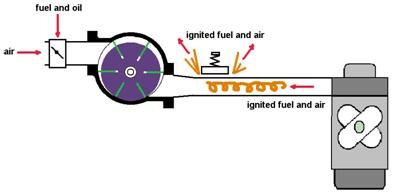
Relief valves operate similarly to the brass valve located on the side of residential hot water heaters. A spring holds the valve shut in normal use. As the supercharger manifold pressure increases, the spring is compressed, opening the valve and letting the pressure flow out to atmosphere. Once the pressure is low enough, the valve reseats and the vehicle can continue to operate (this is handy in the Woolworths carpark).
I will come back in a later post and explain some more about a few more of the control issues - bypasses, wastegates and boost controllers (believe it or not some of that lot applies to Normans ). I will also delve deeper into relief valves, both period and new types.
). I will also delve deeper into relief valves, both period and new types.
Cheers,
Harv (deputy apprentice Norman supercharger mechanic).
Superchargers are put together in two basic configurations:
a) Suck-Through: in this configuration the fuel source (normally a carburetor) is located upstream of the supercharger. The supercharger thus “sucks” the air through the carburetor. The carburetor has no idea that the supercharger exists – although the carburetor will need to flow more fuel/air to keep up with the extra engine power, it still operates under normal vacuum conditions just like a non-supercharged (naturally aspirated) engine. The supercharger in this case handles a mixture of fuel and air (i.e. an explosive air/fuel mixture exists all the way from the carburetor to the engine – all the items shown in red below).

b) Blow-Through: in this configuration the fuel source (a carburetor or fuel injection nozzles) are located downstream of the supercharger. The supercharger thus “blows” air through the carburetor. The carburetor now operates under positive pressure instead of vacuum, often requiring modification to the carburetor (which was designed to operate under engine vacuum). The supercharger in this case handles only air, and the amount of piping and equipment holding an explosive air/fuel mixture (marked in red below) is reduced.

Norman superchargers are normally configured as suck-through. We will now work through why thus is the case.
In very basic terms, we want to feed fuel and air into out engine in vast quantities. The image below shows the Norman supercharger connected up to the cylinder head of our Holden grey motor.

The first challenge that we face is that the supercharger internals have Bakelite vanes that rub against both the steel casing and the steel rotor slots. The vanes require lubrication to reduce the amount of friction (and hence vane wear). The incoming air does not do a great job of acting as a lubricant. We could add an oil squirter upstream of the supercharger, similar to the aftermarket squirter systems used to feed upper cylinder head lubricant (ValveMaster) when running unleaded fuel, or similar to the oilers used on workshop air tools. The image below shows this type of lineup. This type of squirter system, driven by engine vacuum, is commonly used on Judson sliding vane superchargers (the Marvel Mystery Oiler).

However, Eldred Norman found that this type of lubrication did not adequately lubricate the surfaces of the vanes in the rotor slots since centrifugal force tends to fling the oil drops against the casing. A better way of adding lubricant is to mix it in with the fuel. This oil/fuel mixture will then be fed much more evenly over the vanes. To do this, oil is added to the fuel tank (more on this later). By putting the carburetor upstream of the supercharger, the supercharger is fed both air and the fuel/oil mixture. The fuel/oil mixture then acts as a lubricant (and a heat sink) for the vanes. This lineup (suck-through) is shown in the image below.

We will now talk through Norman supercharger control – and most notably the absence of Pssssshhht!
Norman superchargers in suck-through configuration do not need a blow-off valve (sometimes called a dump valve, or BOV). We will now work through why this is the case.
When the carburetor throttle plates are closed (for example during gear changes, as per the image below), the inlet air to the Norman supercharger is closed off.

A slight vacuum will develop between the carburetor and the supercharger, though not a huge one. The supercharger inlet is not fed any air, and hence does not make a huge amount of pressure at the outlet. Boost remains (relatively) stable, and the supercharger does not see a huge load increase.
However, if a blow-through configuration had been utilized (as per the image below, shown with the throttle plate open) then a different phenomena occurs.

When the throttle plate closes, the supercharger has nowhere to discharge to. The inlet to the supercharger is still open, letting the machine suck in air. Because the Norman supercharger is a positive displacement machine, it will keep sucking in and compressing the air, mooshing it up against the closed throttle plate. The trapped boost pressure thus rises rapidly… giving the engine one hell of a shock once the throttle plate opens again. Worse, the supercharger goes into a high pressure, low flow situation called surge (this can sound like chattering in the machine). Surge causes damage to bearings and shafts.
To prevent surge, a blow-off valve would be required as shown in the image below.

The blow-off valve is normally connected to the inlet manifold between the throttle plate and engine (I have not show this sensing line in the diagram for simplicity). When the throttle plate closes, our supercharger starts mooshing up boost against the closed plate. However, the inlet manifold between the throttle plate and engine goes into vacuum. The vacuum is sensed by the blow-off valve, which opens and lets out the excess air. In some cases the air is vented to atmosphere, giving the characteristic Pssssshhht! noise of late model turbo cars during gear changes. The loud noise of course is “very, very sexy mate”, and increases the libido. For those with no need for a libido increase, the blow-off valve can be plumbed back into the inlet manifold as shown in the image below.

By venting off the excess air the supercharger can continue to spin and discharge. This prevents surge from happening. Many late-model vehicles run EFI, with the injection occuring after the supercharger (blow-through) and the throttle plate downstream of the supercharger. These vehicles are the ones commonly heard Psssssshhhhhting their way through traffic.
Blow-off valves are flow controllers – they are designed to ensure a minimum flow through the supercharger and prevent surge. Again, because we are running the Norman supercharger in a suck-through lineup a blow-off valve is not required. Note that a blow-off valve should not be confused with overpressure protection (burst panels or relief valves) which are required on Norman superchargers. We will deal with overpressure protection next.
As we have seen above, Norman superchargers are normally run in suck-through configuration, as per the images above. This means that all the equipment downstream of the carburetor contains an explosive air/fuel mixture – the carburetor-to-blower manifold, the Norman casing, any intercooler used and also the blower-to-cylinder head manifold. The large the amount or size of the equipment, the greater amount of fuel/air mixture and hence the greater potential for an explosion. The ANDRA General Regulations refer to this as Banging the Blower – “an explosion inside the supercharger caused by a flame from the combustion process accidentally re-entering the supercharger, where fuel and air are present. Generally caused by a stuck or broken intake valve that normally would be closed during the combustion sequence”. The more extreme the valve timing (more overlap) the more likely it is that the blower will bang, particularly at low rpm.
Banging the blower can lead interconnecting hoses blowing off, manifold gaskets being blown out and stalling of the supercharger (which can snap vanes and bend rotors). In extreme cases the supercharger can be blown clear off the manifold… one of the reasons that blower restraints are used in some classes of racing.

Belt drives are often used in Norman superchargers as they prevent a blower bang from stalling the crankshaft (they tend to slip instead). Given the risk involved, some form of overpressure protection is required downstream of the carburetors (despite Eldred’s view that a standard car engine using boost up to only 5psi does not warrant pressure protection provided the manifold volume is not too great).
One method to provide pressure protection is to utilize a burst panel. Burst panels function by venting the supercharger casing to ambient pressure with a non-reusable rupture disk or panel. Burst panels are mandated for some racing classes (for example for all ANDRA screw-type superchargers, for Australian Nostalgia Fuel Association Altereds, and for ANDRA Sport Compacts). Burst panels are often specified by guidance published by SFI (http://www.sfifoundation.com/). SFI is a non-profit organization established to issue and administer standards for specialty/performance automotive and racing equipment. SFI’s quality assurance specifications are sanctioned by CAMS, ANDRA and Speedway Australia. SFI Spec 23.1 covers Supercharger Pressure Relief Assemblies, and requires a burst pressure of 200-250psi, and an area of at least 10inch2 (12inch2 if multiple panels are used). This is a very large burst panel for a Norman supercharger, and is really intended for the large capacity race engines seen in drag racing (up to 500ci with 16/71 superchargers). Whilst a (smaller) burst panel could be utilized for a Norman supercharger, their operation is not conducive to road or track use (other than short-duration drag races) as a burst panel effectively puts the vehicle off the road. Whilst it’s not a big deal to change a burst panel at the drag strip, it can be a real pain in the Woolworths car park of a Sunday afternoon.
An alternative to fitting a burst panel is to use a relief valve (sometimes referred to as pop-off valves, sneeze valves or sometimes as blow-off valves). The image below shows a relief valve fitted to our Norman supercharged Holden grey motor.

Relief valves operate similarly to the brass valve located on the side of residential hot water heaters. A spring holds the valve shut in normal use. As the supercharger manifold pressure increases, the spring is compressed, opening the valve and letting the pressure flow out to atmosphere. Once the pressure is low enough, the valve reseats and the vehicle can continue to operate (this is handy in the Woolworths carpark).
I will come back in a later post and explain some more about a few more of the control issues - bypasses, wastegates and boost controllers (believe it or not some of that lot applies to Normans
Cheers,
Harv (deputy apprentice Norman supercharger mechanic).
327 Chev EK wagon, original EK ute for Number 1 Daughter, an FB sedan meth monster project and a BB/MD grey motored FED.
Re: Harv's Norman supercharger thread
Hmmm, will have to keep that in mind. Didn't pick it up when I read my copy of Supercharge. There's a Marvel Mystery Inverse Oiler in my Judson kit. Might fit it for show, but do what Uncle Eldred suggests and add a squirt or two to the tank.Harv wrote:Eldred Norman found that this type of lubrication did not adequately lubricate the surfaces of the vanes in the rotor slots since centrifugal force tends to fling the oil drops against the casing. A better way of adding lubricant is to mix it in with the fuel. This oil/fuel mixture will then be fed much more evenly over the vanes. To do this, oil is added to the fuel tank (more on this later).
Waiting with interest for you to work out just how much oil should be added...
Alan
Member No.1 of the FB EK Holden Car Club of WA (Woo-hoo sweet!)
sweet!)
Member No.1 of the FB EK Holden Car Club of WA (Woo-hoo
Re: Harv's Norman supercharger thread
I got the oil sussed out... subject for another post (I need to eat this elephant one bite at a time  ).
).
PM sent in the meantime.
Cheers,
Harv
PM sent in the meantime.
Cheers,
Harv
327 Chev EK wagon, original EK ute for Number 1 Daughter, an FB sedan meth monster project and a BB/MD grey motored FED.
Re: Harv's Norman supercharger thread
So what about all that other stuff that the Zimm Pirates rant about – Wastegates, Boost Controllers, Intercoolers, Timers and Bypasses? There are a number of pieces of supercharger and turbocharger equipment that are commonly referred to in magazine articles, or seen hanging off the front of late model turbocharged cars. Some do apply to the Norman supercharger, and some don’t.
A wastegate is a valve that diverts (bypasses) exhaust gas away from the turbine wheel in a turbocharger system. Bypassing some of the exhaust gases regulates the turbine speed, which in turn regulates the rotating speed of the compressor. By regulating the compressor speed, the maximum turbocharger boost pressure is controlled. Some wastegates are “integral”, where the bypassed exhaust flow rejoins the rest of the exhaust flow after the turbocharger. Alternatively, a "divorced" wastegate dumps the bypassed exhaust gas directly into the atmosphere. A divorced wastegate outlet pipe is commonly referred to as a “screamer pipe” due to the unmuffled noise they produce. Norman superchargers do not require a wastegate. The supercharger is directly coupled to the crankshaft (via a belt). The speed of the supercharger (and hence the boost pressure) is controlled by engine speed. Maximum boost is determined by the drive pulley sizes, and the ability of the engine to flow air into (and exhaust gas out of) the engine.
A boost controller is a device to control the boost level produced by a turbocharged engine. It does this by changing the air pressure signal sent to the wastegate. Without a boost controller the wastegate is a simple air pressure/piston/opposing spring set up. The boost controller allows the air signal to be varied, and hence the response of the wastegate changed. This lets the wastegate open and shut only when required (and more consistently), reducing turbocharger lag. As a Norman supercharger does not have a wastegate, it usually also does not have a boost controller. Boost controllers are also sometimes made by electronically changing an engines engine management (EFI) software. This type of boost controller is occasionally employed on superchargers. In this case, it is used to make the car behave like it had an underdriven pulley system (low power) whilst putting around town, but also behave like an overdriven pulley system (high power) under load. Given that the Norman supercharger is normally run without complex aftermarket engine management, this kind of boost controller is also not applicable.
Bypass valves are sometimes seen in supercharger systems. At low engine loads the power to drive the supercharger is not always better than the output gained. This parasitic loss can lead to poor fuel economy. The bypass valve open s when throttle loads are low and closes when throttle loads are high. With the bypass valve open there is no pressure being created across the supercharger. This allows the supercharger to not create parasitic drag at low speeds. With the bypass valve closed, all airflow is routed through the supercharger and boost is created. The bypass valve is purely used for economy under low load driving – it is not a boost controller. Bypass valves can be internal (a valve that recirculates air inside the compressor casing) or external (where piping is used to plumb the air around the supercharger). The photograph below the internal (brass) bypass valve inside an Eaton MP90 supercharger inlet.
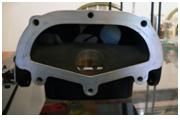
External bypass valves are used in some Norman superchargers, most notably the 110 Deluxe model. This supercharger had a hydraulic clutch driven by engine oil pressure. The clutch could be operated from a button on the dash, disconnected and connecting the supercharger drive at will. This is a bit different to a modern supercharger, which leaves the supercharging spinning when bypassed. When the Norman supercharger is disconnected, the engine becomes just like any naturally aspirated engine. It is however trying it’s hardest to suck fuel and air past the supercharger vanes… a hard task that would cause a huge loss of efficiency, even with the supercharger slowly freewheeling around under vacuum. To help the engine out, a bypass pipe and flapper valve system was installed to allow air to flow from the carburetor outlet straight to the inlet manifold, as per the image below:
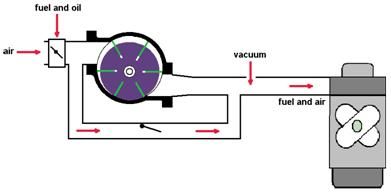
The photograph below shows the bypass pipe linking the inlet and outlet side of the Norman supercharger:
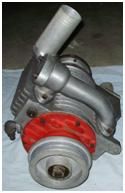
The same SU carburetor is used for both supercharged and bypassed operation. Under bypass mode the carburetor dashpot does not open fully, whilst under supercharged loads it opens more and more. This ability of SU carburettors to have a small venturi at low engine load gives good throttle response, and prevents fuel starvation. If a fixed venturi carburetor was used (for example a set of triple or twin standard grey motor Strombergs), the low engine load could give very little “suck” across the large (fixed) venturis, leading to little fuel flow and leanout.
There are a number of downsides to having a bypass valve installed:
• Norman superchargers do not have internal bypass valves, so an external valve must be used. This takes up extra space in the engine compartment.
• if the bypass valve does not seal very well, it can cause loss of boost pressure under load (the supercharger will recycle on itself).
• most Norman supercharger owners are very unlikely to turn the supercharger off. Whilst the bypass will still open under low load conditions, the better fuel consumption is negated somewhat by the supercharger still being driven.
Practically, if the Norman supercharger is one of the Deluxe models with a bypass then it will probably be used, if only for nostalgia sake. If the supercharger does not have a bypass installed, then it is does not require one.
The compression of air/fuel in the supercharging process does generate heat. Some of the heat comes from the vanes scraping the casing, some from the vanes sliding in the rotor, and some from friction in the bearings. The heat from the vanes can be removed to some extent by water cooling the supercharger (some Norman superchargers have a water jacket around the casing which connects to the normal car radiator system). However, a substantive amount of heat is also generated by the compression process itself. The easiest way to visualize this heat is with a simple bicycle pump. Pump a bike tyre up to a decent pressure, then put your hand on the flexible rubber connecting hose – the heat that you can feel is mostly the heat of compression. Heat is not a good thing in a supercharger. It can lead to poor lubrication, and increased bearing/vane wear. Worse, the heat does two things to the incoming air:
a) It makes the air less dense (thinner). After all that hard work compressing the air, it is a shame that the air gets less dense, negating some of our hard work. The less dense air means less fuel/air mixture can be jammed into the engine, and hence less power than we had hoped for.
b) The increased temperature makes the combustion process hotter, and moves us closer to the fuel igniting before we are ready. This pre-ignition is referred to as knocking (sometimes as “pinging” or “pinking”). Knocking can do a substantive amount of damage to an engine, including blowing out head gaskets, smashing piston ring lands and stressing bearings. To combat knocking we can some things (like retarding the ignition timing, adding water injection or running higher octane fuels), each of which comes at a price… usually less power and/or more cost.
One way to combat this increase in temperature is to intercool the supercharger. Intercoolers are shown in the diagram below:
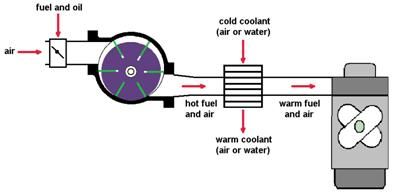
The benefits of intercooling are considerable… around 40-60% additional power from a supercharged vehicle. An intercooler may be:
• nothing more than a glorified radiator (referred to as an air-to-air intercooler). This is the shiny aluminium fixture often seen at the front of modern turbo cars after half the bumper bar and grille has been cut away,
• a full heat exchanger with the supercharged air on one side and water on the other (a water-to-air intercooler),
• a spray of cold compressed gas over the front of a glorified radiator,
• a box packed with dry ice with the supercharged air passing through internal tubes (kinda hard to top up the dry ice… this is mainly a drag race approach).
Intercoolers were used on some Norman superchargers. For example the photograph below shows a Type 110 Deluxe supercharger with the (factory) air-to-air intercooler labeled as 6. This intercooler is a cast aluminium casing, with the air/fuel charge passing through. Cooling is achieved by the cooling fins alone.
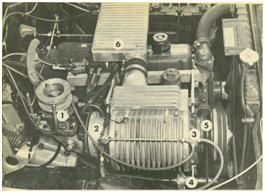
There are however some down-sides to intercooling:
• the intercooler and piping have a pressure drop. This reduces boost pressure. We can combat this to some extent though by making the supercharger run a little faster (smaller driven pulley) provided we are not already at the limit of what the supercharger can produce.
• the intercooler takes up additional space under the bonnet.
• water/air intercoolers utilizing the cars coolant system will circulate warm water. When the car is under low load, the air passing through the intercooler may be colder than the engine coolant. In this case the intercooler acts as an “interheater”, reducing charge density instead of increasing it.
• the intercooler increases the volume of the inlet system. As Norman sueprchargers are suck-through line-ups, all the inlet system contains an explosive air/fuel mixture. Increasing the volume (by adding an intercooler) increases the size of the potential explosion. To quote Eldred: “Intercoolers are not really feasible. If they are large enough to be effective they form a too large reservoir for the mixture, and when there is a backfire it is almost of nuclear proportions.”.
Practically, if the Norman supercharger has an intercooler then it will probably be used, if only for nostalgia sake. If the supercharger does not have an intercooler, then one may be installed to chase additional horsepower. For those looking for a period-correct installation, or are concerned over the potential to damage the supercharger installation by explosion, an intercooler is not required.
A turbo timer is an electronic device which keeps the engine running (at idle) for a period of time after you turn the key off. It does this allow low-boost, cool air to cool down the exhaust and intake tracts (remember that the turbocharger is driven by exhaust gas, and can become incredibly hot under load). At the same time the engine oil is able to circulate, preventing the red-hot turbo bearings from cooking the oil to carbon (…or melting). Norman superchargers do not suffer from the same high temperatures as a turbocharger. However, they do increase in heat under load. Whilst a turbo timer is not required, it is god practice to drive the car under low load (or at idle) for a few minutes between high load operation and shut down.
So in short:
• Norman superchargers are normally suck-through line-ups.
• a blow-off valve is a flow control device used to protect superchargers from surge. It is not required on a Norman supercharged vehicle.
• a relief valve is an overpressure control device used to protect against explosion inside a supercharger. It is required on a Norman supercharged vehicle.
• a wastegate is a rotational speed and boost pressure control device. It is not required on a Norman supercharged vehicle.
• a boost controller is a device that changes how a wastegate behaves to optimize boost pressure delivery. It is not required on a Norman supercharged vehicle.
• a bypass valve is a device that improves economy at low supercharger load. They are present in Deluxe Norman superchargers, but otherwise not required on a Norman supercharged vehicle.
• an intercooler is a device used to get more supercharged air into a vehicle and reduce knocking. They are present in some Norman supercharger installations. Whilst they can add additional horsepower they increase the risk of explosion and are not absolutely required.
• a turbo timer is a device that allows a hot turbocharger to cool down properly. It is not required on a Norman supercharged vehicle.
Cheers,
Harv (deputy aprentice Norman supercharger fiddler).
A wastegate is a valve that diverts (bypasses) exhaust gas away from the turbine wheel in a turbocharger system. Bypassing some of the exhaust gases regulates the turbine speed, which in turn regulates the rotating speed of the compressor. By regulating the compressor speed, the maximum turbocharger boost pressure is controlled. Some wastegates are “integral”, where the bypassed exhaust flow rejoins the rest of the exhaust flow after the turbocharger. Alternatively, a "divorced" wastegate dumps the bypassed exhaust gas directly into the atmosphere. A divorced wastegate outlet pipe is commonly referred to as a “screamer pipe” due to the unmuffled noise they produce. Norman superchargers do not require a wastegate. The supercharger is directly coupled to the crankshaft (via a belt). The speed of the supercharger (and hence the boost pressure) is controlled by engine speed. Maximum boost is determined by the drive pulley sizes, and the ability of the engine to flow air into (and exhaust gas out of) the engine.
A boost controller is a device to control the boost level produced by a turbocharged engine. It does this by changing the air pressure signal sent to the wastegate. Without a boost controller the wastegate is a simple air pressure/piston/opposing spring set up. The boost controller allows the air signal to be varied, and hence the response of the wastegate changed. This lets the wastegate open and shut only when required (and more consistently), reducing turbocharger lag. As a Norman supercharger does not have a wastegate, it usually also does not have a boost controller. Boost controllers are also sometimes made by electronically changing an engines engine management (EFI) software. This type of boost controller is occasionally employed on superchargers. In this case, it is used to make the car behave like it had an underdriven pulley system (low power) whilst putting around town, but also behave like an overdriven pulley system (high power) under load. Given that the Norman supercharger is normally run without complex aftermarket engine management, this kind of boost controller is also not applicable.
Bypass valves are sometimes seen in supercharger systems. At low engine loads the power to drive the supercharger is not always better than the output gained. This parasitic loss can lead to poor fuel economy. The bypass valve open s when throttle loads are low and closes when throttle loads are high. With the bypass valve open there is no pressure being created across the supercharger. This allows the supercharger to not create parasitic drag at low speeds. With the bypass valve closed, all airflow is routed through the supercharger and boost is created. The bypass valve is purely used for economy under low load driving – it is not a boost controller. Bypass valves can be internal (a valve that recirculates air inside the compressor casing) or external (where piping is used to plumb the air around the supercharger). The photograph below the internal (brass) bypass valve inside an Eaton MP90 supercharger inlet.

External bypass valves are used in some Norman superchargers, most notably the 110 Deluxe model. This supercharger had a hydraulic clutch driven by engine oil pressure. The clutch could be operated from a button on the dash, disconnected and connecting the supercharger drive at will. This is a bit different to a modern supercharger, which leaves the supercharging spinning when bypassed. When the Norman supercharger is disconnected, the engine becomes just like any naturally aspirated engine. It is however trying it’s hardest to suck fuel and air past the supercharger vanes… a hard task that would cause a huge loss of efficiency, even with the supercharger slowly freewheeling around under vacuum. To help the engine out, a bypass pipe and flapper valve system was installed to allow air to flow from the carburetor outlet straight to the inlet manifold, as per the image below:

The photograph below shows the bypass pipe linking the inlet and outlet side of the Norman supercharger:

The same SU carburetor is used for both supercharged and bypassed operation. Under bypass mode the carburetor dashpot does not open fully, whilst under supercharged loads it opens more and more. This ability of SU carburettors to have a small venturi at low engine load gives good throttle response, and prevents fuel starvation. If a fixed venturi carburetor was used (for example a set of triple or twin standard grey motor Strombergs), the low engine load could give very little “suck” across the large (fixed) venturis, leading to little fuel flow and leanout.
There are a number of downsides to having a bypass valve installed:
• Norman superchargers do not have internal bypass valves, so an external valve must be used. This takes up extra space in the engine compartment.
• if the bypass valve does not seal very well, it can cause loss of boost pressure under load (the supercharger will recycle on itself).
• most Norman supercharger owners are very unlikely to turn the supercharger off. Whilst the bypass will still open under low load conditions, the better fuel consumption is negated somewhat by the supercharger still being driven.
Practically, if the Norman supercharger is one of the Deluxe models with a bypass then it will probably be used, if only for nostalgia sake. If the supercharger does not have a bypass installed, then it is does not require one.
The compression of air/fuel in the supercharging process does generate heat. Some of the heat comes from the vanes scraping the casing, some from the vanes sliding in the rotor, and some from friction in the bearings. The heat from the vanes can be removed to some extent by water cooling the supercharger (some Norman superchargers have a water jacket around the casing which connects to the normal car radiator system). However, a substantive amount of heat is also generated by the compression process itself. The easiest way to visualize this heat is with a simple bicycle pump. Pump a bike tyre up to a decent pressure, then put your hand on the flexible rubber connecting hose – the heat that you can feel is mostly the heat of compression. Heat is not a good thing in a supercharger. It can lead to poor lubrication, and increased bearing/vane wear. Worse, the heat does two things to the incoming air:
a) It makes the air less dense (thinner). After all that hard work compressing the air, it is a shame that the air gets less dense, negating some of our hard work. The less dense air means less fuel/air mixture can be jammed into the engine, and hence less power than we had hoped for.
b) The increased temperature makes the combustion process hotter, and moves us closer to the fuel igniting before we are ready. This pre-ignition is referred to as knocking (sometimes as “pinging” or “pinking”). Knocking can do a substantive amount of damage to an engine, including blowing out head gaskets, smashing piston ring lands and stressing bearings. To combat knocking we can some things (like retarding the ignition timing, adding water injection or running higher octane fuels), each of which comes at a price… usually less power and/or more cost.
One way to combat this increase in temperature is to intercool the supercharger. Intercoolers are shown in the diagram below:

The benefits of intercooling are considerable… around 40-60% additional power from a supercharged vehicle. An intercooler may be:
• nothing more than a glorified radiator (referred to as an air-to-air intercooler). This is the shiny aluminium fixture often seen at the front of modern turbo cars after half the bumper bar and grille has been cut away,
• a full heat exchanger with the supercharged air on one side and water on the other (a water-to-air intercooler),
• a spray of cold compressed gas over the front of a glorified radiator,
• a box packed with dry ice with the supercharged air passing through internal tubes (kinda hard to top up the dry ice… this is mainly a drag race approach).
Intercoolers were used on some Norman superchargers. For example the photograph below shows a Type 110 Deluxe supercharger with the (factory) air-to-air intercooler labeled as 6. This intercooler is a cast aluminium casing, with the air/fuel charge passing through. Cooling is achieved by the cooling fins alone.

There are however some down-sides to intercooling:
• the intercooler and piping have a pressure drop. This reduces boost pressure. We can combat this to some extent though by making the supercharger run a little faster (smaller driven pulley) provided we are not already at the limit of what the supercharger can produce.
• the intercooler takes up additional space under the bonnet.
• water/air intercoolers utilizing the cars coolant system will circulate warm water. When the car is under low load, the air passing through the intercooler may be colder than the engine coolant. In this case the intercooler acts as an “interheater”, reducing charge density instead of increasing it.
• the intercooler increases the volume of the inlet system. As Norman sueprchargers are suck-through line-ups, all the inlet system contains an explosive air/fuel mixture. Increasing the volume (by adding an intercooler) increases the size of the potential explosion. To quote Eldred: “Intercoolers are not really feasible. If they are large enough to be effective they form a too large reservoir for the mixture, and when there is a backfire it is almost of nuclear proportions.”.
Practically, if the Norman supercharger has an intercooler then it will probably be used, if only for nostalgia sake. If the supercharger does not have an intercooler, then one may be installed to chase additional horsepower. For those looking for a period-correct installation, or are concerned over the potential to damage the supercharger installation by explosion, an intercooler is not required.
A turbo timer is an electronic device which keeps the engine running (at idle) for a period of time after you turn the key off. It does this allow low-boost, cool air to cool down the exhaust and intake tracts (remember that the turbocharger is driven by exhaust gas, and can become incredibly hot under load). At the same time the engine oil is able to circulate, preventing the red-hot turbo bearings from cooking the oil to carbon (…or melting). Norman superchargers do not suffer from the same high temperatures as a turbocharger. However, they do increase in heat under load. Whilst a turbo timer is not required, it is god practice to drive the car under low load (or at idle) for a few minutes between high load operation and shut down.
So in short:
• Norman superchargers are normally suck-through line-ups.
• a blow-off valve is a flow control device used to protect superchargers from surge. It is not required on a Norman supercharged vehicle.
• a relief valve is an overpressure control device used to protect against explosion inside a supercharger. It is required on a Norman supercharged vehicle.
• a wastegate is a rotational speed and boost pressure control device. It is not required on a Norman supercharged vehicle.
• a boost controller is a device that changes how a wastegate behaves to optimize boost pressure delivery. It is not required on a Norman supercharged vehicle.
• a bypass valve is a device that improves economy at low supercharger load. They are present in Deluxe Norman superchargers, but otherwise not required on a Norman supercharged vehicle.
• an intercooler is a device used to get more supercharged air into a vehicle and reduce knocking. They are present in some Norman supercharger installations. Whilst they can add additional horsepower they increase the risk of explosion and are not absolutely required.
• a turbo timer is a device that allows a hot turbocharger to cool down properly. It is not required on a Norman supercharged vehicle.
Cheers,
Harv (deputy aprentice Norman supercharger fiddler).
327 Chev EK wagon, original EK ute for Number 1 Daughter, an FB sedan meth monster project and a BB/MD grey motored FED.
Re: Harv's Norman supercharger thread
One question that commonly comes up is “just how much grunt will I get from a Norman?”. In the next few posts I will take a long look at the performance of Norman superchargers. Some of this will be geeky, engineering modeling of how superchargers work (my apologies in advance for those not inclined), whilst some will be comparing factory and road test results.
Whilst it is possible to install and field test Norman superchargers (the “suck it and see” approach), there are some difficulties in doing so:
• There are not all that many Norman superchargers around, and the few that are available are (rightly) viewed as valuable. Convincing someone to allow you to bolt up their supercharger and then test the boundaries of it’s performance is not likely to be an easy task,
• There are quite a few variables that need examining. It can be a very expensive process sourcing multiple supercharger drive pulleys (for example), let alone the time and cost of either road or dynamometer testing,
• The cost of failure can be expensive. A severely knocking engine under load can very quickly lead to engine failure, and
• It has been a considerable time since the Norman supercharger was built. Over the last half century, supercharging technology has increased in leaps and bounds. The increase in technology also means that our expectations of superchargers has changed. Our mental model of “normal supercharging” now includes 15 psi boost pressures, huge intercoolers and EFI. Whilst some of these expectations are applicable to Norman superchargers, many are not… or at least not when the “traditional approach” to using a Norman is desired.
The modeling process involves estimating some issues (for example how efficient the superchargers are), and then calculating what the likely supercharger performance will be (power output, onset of knocking, impacts on bearing design etc). It is recognized that this process is only an estimate – the information below should not be seen as “hard and fast” rules, but rather as a guide or starting point to what these superchargers are capable of. Where I have made assumptions (for example in volumetric efficiencies) I will highlight the likely range of the value involved.
In order to model the performance of Norman superchargers, we need a starting point. I have drawn the data below from the respective factory Workshop Manuals:

There are lots of tricky numbers in that table, so let’s make it simple by using a number that is more familiar – quarter mile time. To estimate the likely unblown performance of the above vehicles, it is possible to estimate the quarter mile elapsed time (ET) using a formula often referred to as “racer math”. The racer math formula is:
ET = 5.825 x (weight/power)1/3
Where:
• Elapsed time is the time for the vehicle to travel the quarter mile drag strip, and is in seconds,
• Weight is the vehicle weight in pounds, and
• Power is the vehicle brake horsepower.
Applying the formula to the early Holdens above yields the following:

No suprises here – the Holdens get quicker and quicker with each new model, with a big change in performance when the red motor was introduced into the EH Holden.
Now that we have a starting point, the key question at this point is just how much power can be squeezed out of a Norman supercharger. As an example, we can take the following anecdote as noted in Supercharge by Eldred Norman:
“In 1954, driving a supercharged Triumph TR2, I finished 4th in the Australian Grand Prix. On this car I used a “boost’ of 12lbs. The supercharger was a G.M. 271 Roots type unit operating at 1.1 times engine speed and driven by four ‘A’ section V belts. By the end of the race belt-slips had caused a fall in boost to a maximum of 8 lbs. Naturally I had to ‘nurse’ the belts by not using full throttle at this stage. My present Holden is some 50% greater in capacity than was the Triumph. I am using a 10 lb. supercharge from my type 110 vane type supercharger and drive it with only two ‘A’ section belts. Under these conditions the vane type is putting out almost 40% more air/fuel than did the Roots with twice the number of belts. Certainly the car is not being raced which is an enormous difference. But my belts last at least 5000 miles of normal road use. Detractors of the vane type supercharger have usually only seen the wrong unit on the job.”
The Triumph TR2 has an engine capacity of 121ci, inferring Eldred’s Holden had a capacity of 182ci. This could be either of the 179ci or 186ci Holden red motors, allowing for rounding of numbers. If we assume that this was Eldred’s reknowned HR Holden with a 186ci motor, with a weight of 2600lb (1180kg), and a performance of 0-100mph in 14 seconds (as per the cover page of Supercharge), then we can use the estimator at the following site (http://www.torquestats.com/modified/ind ... calculator) to estimate the power as being 232BHP. The increase from the HR Holden’s naturally aspirated 145 BHP is some 60%.
A power increase of around 60% seems a fair boundary for the Norman supercharger. This seems low compared to the ~100% increases that can be achieved with modern intercooled supercharging. However, bear in mind that early Holden motors (and particularly the grey motor) have fairly poor flowing cylinder heads, and a limited ability to absorb additional power without snapping cranks or smashing gearboxes, and that intercooling a Norman is no easy task (more on this later).
I will use 60% in the information below. Applying the “racer math” formula but with some increased horsepower shows the following quarter mile elapsed times are probably achievable with a Norman supercharger:
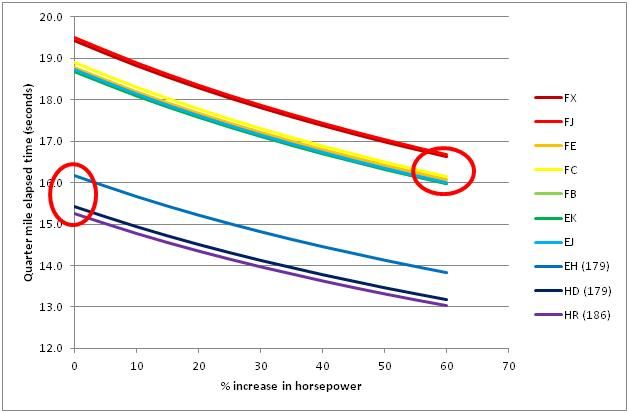
This shows that our Norman blown grey motor, pumping out an additional 60% more power, should be good for around 16 second quarter miles. Whilst not too great in comparison to modern 10-second quarter mile times, it’s not too bad considering that our 60% blown grey is probably still quite a streetable car with none of the lumpy cam, methanol slurping, high geared misbehaviour. Note the two red circles I have drawn on the graph. These show that our blown 60% grey is still only just as quick as an unblown red – a sad fact of life. This is not to say that you cannot squeeze more grunt out of a Norman supercharged grey... just that the results will be typically around the above.
More on Norman power in the next few posts.
Cheers,
Harv (deputy apprentice Norman supercharger fiddler).
Whilst it is possible to install and field test Norman superchargers (the “suck it and see” approach), there are some difficulties in doing so:
• There are not all that many Norman superchargers around, and the few that are available are (rightly) viewed as valuable. Convincing someone to allow you to bolt up their supercharger and then test the boundaries of it’s performance is not likely to be an easy task,
• There are quite a few variables that need examining. It can be a very expensive process sourcing multiple supercharger drive pulleys (for example), let alone the time and cost of either road or dynamometer testing,
• The cost of failure can be expensive. A severely knocking engine under load can very quickly lead to engine failure, and
• It has been a considerable time since the Norman supercharger was built. Over the last half century, supercharging technology has increased in leaps and bounds. The increase in technology also means that our expectations of superchargers has changed. Our mental model of “normal supercharging” now includes 15 psi boost pressures, huge intercoolers and EFI. Whilst some of these expectations are applicable to Norman superchargers, many are not… or at least not when the “traditional approach” to using a Norman is desired.
The modeling process involves estimating some issues (for example how efficient the superchargers are), and then calculating what the likely supercharger performance will be (power output, onset of knocking, impacts on bearing design etc). It is recognized that this process is only an estimate – the information below should not be seen as “hard and fast” rules, but rather as a guide or starting point to what these superchargers are capable of. Where I have made assumptions (for example in volumetric efficiencies) I will highlight the likely range of the value involved.
In order to model the performance of Norman superchargers, we need a starting point. I have drawn the data below from the respective factory Workshop Manuals:

There are lots of tricky numbers in that table, so let’s make it simple by using a number that is more familiar – quarter mile time. To estimate the likely unblown performance of the above vehicles, it is possible to estimate the quarter mile elapsed time (ET) using a formula often referred to as “racer math”. The racer math formula is:
ET = 5.825 x (weight/power)1/3
Where:
• Elapsed time is the time for the vehicle to travel the quarter mile drag strip, and is in seconds,
• Weight is the vehicle weight in pounds, and
• Power is the vehicle brake horsepower.
Applying the formula to the early Holdens above yields the following:

No suprises here – the Holdens get quicker and quicker with each new model, with a big change in performance when the red motor was introduced into the EH Holden.
Now that we have a starting point, the key question at this point is just how much power can be squeezed out of a Norman supercharger. As an example, we can take the following anecdote as noted in Supercharge by Eldred Norman:
“In 1954, driving a supercharged Triumph TR2, I finished 4th in the Australian Grand Prix. On this car I used a “boost’ of 12lbs. The supercharger was a G.M. 271 Roots type unit operating at 1.1 times engine speed and driven by four ‘A’ section V belts. By the end of the race belt-slips had caused a fall in boost to a maximum of 8 lbs. Naturally I had to ‘nurse’ the belts by not using full throttle at this stage. My present Holden is some 50% greater in capacity than was the Triumph. I am using a 10 lb. supercharge from my type 110 vane type supercharger and drive it with only two ‘A’ section belts. Under these conditions the vane type is putting out almost 40% more air/fuel than did the Roots with twice the number of belts. Certainly the car is not being raced which is an enormous difference. But my belts last at least 5000 miles of normal road use. Detractors of the vane type supercharger have usually only seen the wrong unit on the job.”
The Triumph TR2 has an engine capacity of 121ci, inferring Eldred’s Holden had a capacity of 182ci. This could be either of the 179ci or 186ci Holden red motors, allowing for rounding of numbers. If we assume that this was Eldred’s reknowned HR Holden with a 186ci motor, with a weight of 2600lb (1180kg), and a performance of 0-100mph in 14 seconds (as per the cover page of Supercharge), then we can use the estimator at the following site (http://www.torquestats.com/modified/ind ... calculator) to estimate the power as being 232BHP. The increase from the HR Holden’s naturally aspirated 145 BHP is some 60%.
A power increase of around 60% seems a fair boundary for the Norman supercharger. This seems low compared to the ~100% increases that can be achieved with modern intercooled supercharging. However, bear in mind that early Holden motors (and particularly the grey motor) have fairly poor flowing cylinder heads, and a limited ability to absorb additional power without snapping cranks or smashing gearboxes, and that intercooling a Norman is no easy task (more on this later).
I will use 60% in the information below. Applying the “racer math” formula but with some increased horsepower shows the following quarter mile elapsed times are probably achievable with a Norman supercharger:

This shows that our Norman blown grey motor, pumping out an additional 60% more power, should be good for around 16 second quarter miles. Whilst not too great in comparison to modern 10-second quarter mile times, it’s not too bad considering that our 60% blown grey is probably still quite a streetable car with none of the lumpy cam, methanol slurping, high geared misbehaviour. Note the two red circles I have drawn on the graph. These show that our blown 60% grey is still only just as quick as an unblown red – a sad fact of life. This is not to say that you cannot squeeze more grunt out of a Norman supercharged grey... just that the results will be typically around the above.
More on Norman power in the next few posts.
Cheers,
Harv (deputy apprentice Norman supercharger fiddler).
327 Chev EK wagon, original EK ute for Number 1 Daughter, an FB sedan meth monster project and a BB/MD grey motored FED.
Re: Harv's Norman supercharger thread
OK, onto some more "geeky" stuff - modelling the Norman.
I have performed the calculations below in a manner consistent with the guidance in Supercharged! Design, Testing and Installation of Supercharger Systems by Corky Bell. In doing so, I have made the following assumptions:
a) I have assumed that the Holden grey motor engine volumetric efficiency (VE) is 80%.
• Holley Carburettors, Manifolds and Fuel Injection by Mike Ulrich indicates that ordinary, low performance engines (this sounds like a typical grey motor!) have a VE of 80% a maximum torque, high performance engines 85% and all-out racing engines 95%.
• Garrett (the turbocharger manufacturer) indicates that volumetric efficiency ranges in the 95%-99% for modern 4-valve heads and 88% - 95% for 2-valve designs (whilst the grey motor has two valves, it is nowhere near contemporary).
• EPI Engineering (http://www.epi-eng.com/index.html) indicates that in general automotive engines rarely exceed 90% VE.
b) I have assumed that the Norman supercharger volumetric efficiency is 90%.
• From The Standard Handbook of Petroleum and Natural Gas Engineering, Volume 1 (edited by William Lyons) sliding vane compressor volumetric efficiency ranges from 82% to 90%, with 82% representing higher boost pressures.
• From Compressors: Selection and Sizing by Royce Brown, sliding vane compressor volumetric efficiencies range from 90% at 10psig (a typical Norman supercharger pressure) to 85% at 30 psig (way too high a pressure for a Norman supercharger).
• From The Internal Combustion Engine in Theory and Practice by C. F. Taylor, sliding vane compressor volumetric efficiency is typically 85%.
c) I have assumed that the adiabatic efficiency of the Norman supercharger is 60%.
• Supercharge by Eldred Norman indicates that Roots superchargers have an adiabatic efficiency of about 50%, sliding vanes superchargers 70% and centrifugal superchargers 90%. These values seem high in comparison to the numbers below.
• Supercharged! Design Testing and Installation of Supercharger Systems by Corky Bell indicates that supercharger adiabatic efficiency is in the range 50-65%.
d) I have assumed that the Norman supercharger drive power efficiency is 90%. Supercharged! Design Testing and Installation of Supercharger Systems by Corky Bell which indicates the following for drive power efficiency (and utilises a constant 90% for all calculations):
• 5psi boost: 93%,
• 10psi boost: 90%, and
• 15psi boost: 86%.
e) I have assumed that the Norman supercharger thermal efficiency is 65% (higher than the Roots supercharger due to the sliding vanes internal pressure ratio, but lower than the twin screw/centrifugal supercharger due to the heat generated by the vanes moving against the casing).
• Supercharged! Design Testing and Installation of Supercharger Systems by Corky Bell indicates the following efficiencies:
Roots supercharger: 55%,
Twin-screw supercharger: 70%,
Centrifugal supercharger: 75%, and
Typical turbocharger: 75%.
• The Internal Combustion Engine in Theory and Practice by C. F. Taylor indicates a mechanical efficiency of 65%.
f) I have assumed that the ambient air temperature is 35ºC (96ºF using the normal temperature scale). This number is converted to the absolute temperature scale for the calculations below by adding 460ºF (i.e. 35ºC = 96 + 460 = 556ºFabsolute).
The calculation process is an iterative (cyclic) one – you make some initial estimates of boost, calculate the resultant supercharger outlet temperature, and then calculate boost. You feed the newly calculated boost back into the start of the cycle again, and keep cycling around until the numbers coming out are constant.
For the example below, I will assume a Holden 138ci grey motor (75BHP from the factory, 7.25:1 compression ratio and 4200rpm redline) with a target of 50% power increase (say 110 BHP) once supercharged. I will model the small Norman (82.79 inch3/revolution).
First iteration – this will allow us to make a first guess of the boost required, and how hot the air will be leaving the compressor.
1. Volumetric efficiencies ratio = (supercharger VE/engine VE) = (90/80) = 1.125 (this number will remain constant throughout the calculations).
2. Pressure ratio = (desired horsepower/existing horsepower) = (110/75) = 1.47 (this number we will keep calculating/updating in the iteration cycles below).
3. Boost = (pressure ratio – 1) x atmospheric pressure = (1.47-1) x 14.7psi = 6.91psi (this number is our first guess of the boost required, and will change as we will keep calculating in the iteration cycles below).
4. Drive power efficiency = -0.7 x boost + 96.667 = -0.7 x 6.91 + 96.667 = 91.8% (this number we will keep calculating/updating in the iteration cycles below).
5. Temperature gain across the supercharger = ((pressure ratio^0.28)-1)xTabsolute/thermal eficiency = ((1.47^0.28)-1)x556/0.65 = 97ºF (this number is our first guess at the temperature rise that the supercharger imparts to the air that it is compressing, and will change as we will keep calculating in the iteration cycles below).
Second iteration – this will let us update our estimate of boost and outlet temperature.
1. Density ratio = supercharger inlet temperature/supercharger outlet temperature = 556/(556+97) = 0.851 (this number we will keep calculating/updating in the iteration cycles below).
2. Pressure ratio = desired horsepower/(existing horsepower x densiy ratio x volumetric efficiencies ratio x drive power efficiency) = 110/(75x0.851x1.125x0.918) = 1.669 (this is our second guess at the pressure ratio).
3. Boost = (pressure ratio – 1) x atmospheric pressure = (1.669-1) x 14.7 = 9.83psi (this is our second guess at the boost pressure required).
4. Drive power efficiency = -0.7 x boost + 96.667 = -0.7 x 9.83 + 96.667 = 90% (this number we will keep calculating/updating in the iteration cycles below).
5. Temperature gain across the supercharger = ((pressure ratio^0.28)-1)xTabsolute/thermal eficiency = ((1.669^0.28)-1)x556/0.65 = 132ºF (this is our second guess at the supercharger temperature increase).
Third iteration – again updating our estimate of boost and outlet temperature.
1. Density ratio = supercharger inlet temperature/supercharger outlet temperature = 556/(556+132) = 0.808
2. Pressure ratio = desired horsepower/(existing horsepower x densiy ratio x volumetric efficiencies ratio x drive power efficiency) = 110/(75x0.808x1.125x0.90) = 1.79
3. Boost = (pressure ratio – 1) x atmospheric pressure = (1.79-1) x 14.7 = 11.6psi (this is our third guess at the boost pressure required).
4. Drive power efficiency = -0.7 x boost + 96.667 = -0.7 x 11.6 + 96.667 = 88.5% (this number we will keep calculating/updating in the iteration cycles below).
5. Temperature gain =((pressure ratio^0.28)-1)xTabsolute/thermal eficiency = ((1.79^0.28)-1)x556/0.65 = 151ºF (this is our third guess at the supercharger temperature increase).
If we keep iterating around and around again (Microsoft Excel is great for this), the numbers in our example finally stabilise as follows:
• Boost = 12.9psi
• Pressure ratio = 1.47
• Temperature gain = 165ºF
I'll run some more numbers and show what this means for our small Norman in the next post.
Cheers,
Harv
I have performed the calculations below in a manner consistent with the guidance in Supercharged! Design, Testing and Installation of Supercharger Systems by Corky Bell. In doing so, I have made the following assumptions:
a) I have assumed that the Holden grey motor engine volumetric efficiency (VE) is 80%.
• Holley Carburettors, Manifolds and Fuel Injection by Mike Ulrich indicates that ordinary, low performance engines (this sounds like a typical grey motor!) have a VE of 80% a maximum torque, high performance engines 85% and all-out racing engines 95%.
• Garrett (the turbocharger manufacturer) indicates that volumetric efficiency ranges in the 95%-99% for modern 4-valve heads and 88% - 95% for 2-valve designs (whilst the grey motor has two valves, it is nowhere near contemporary).
• EPI Engineering (http://www.epi-eng.com/index.html) indicates that in general automotive engines rarely exceed 90% VE.
b) I have assumed that the Norman supercharger volumetric efficiency is 90%.
• From The Standard Handbook of Petroleum and Natural Gas Engineering, Volume 1 (edited by William Lyons) sliding vane compressor volumetric efficiency ranges from 82% to 90%, with 82% representing higher boost pressures.
• From Compressors: Selection and Sizing by Royce Brown, sliding vane compressor volumetric efficiencies range from 90% at 10psig (a typical Norman supercharger pressure) to 85% at 30 psig (way too high a pressure for a Norman supercharger).
• From The Internal Combustion Engine in Theory and Practice by C. F. Taylor, sliding vane compressor volumetric efficiency is typically 85%.
c) I have assumed that the adiabatic efficiency of the Norman supercharger is 60%.
• Supercharge by Eldred Norman indicates that Roots superchargers have an adiabatic efficiency of about 50%, sliding vanes superchargers 70% and centrifugal superchargers 90%. These values seem high in comparison to the numbers below.
• Supercharged! Design Testing and Installation of Supercharger Systems by Corky Bell indicates that supercharger adiabatic efficiency is in the range 50-65%.
d) I have assumed that the Norman supercharger drive power efficiency is 90%. Supercharged! Design Testing and Installation of Supercharger Systems by Corky Bell which indicates the following for drive power efficiency (and utilises a constant 90% for all calculations):
• 5psi boost: 93%,
• 10psi boost: 90%, and
• 15psi boost: 86%.
e) I have assumed that the Norman supercharger thermal efficiency is 65% (higher than the Roots supercharger due to the sliding vanes internal pressure ratio, but lower than the twin screw/centrifugal supercharger due to the heat generated by the vanes moving against the casing).
• Supercharged! Design Testing and Installation of Supercharger Systems by Corky Bell indicates the following efficiencies:
Roots supercharger: 55%,
Twin-screw supercharger: 70%,
Centrifugal supercharger: 75%, and
Typical turbocharger: 75%.
• The Internal Combustion Engine in Theory and Practice by C. F. Taylor indicates a mechanical efficiency of 65%.
f) I have assumed that the ambient air temperature is 35ºC (96ºF using the normal temperature scale). This number is converted to the absolute temperature scale for the calculations below by adding 460ºF (i.e. 35ºC = 96 + 460 = 556ºFabsolute).
The calculation process is an iterative (cyclic) one – you make some initial estimates of boost, calculate the resultant supercharger outlet temperature, and then calculate boost. You feed the newly calculated boost back into the start of the cycle again, and keep cycling around until the numbers coming out are constant.
For the example below, I will assume a Holden 138ci grey motor (75BHP from the factory, 7.25:1 compression ratio and 4200rpm redline) with a target of 50% power increase (say 110 BHP) once supercharged. I will model the small Norman (82.79 inch3/revolution).
First iteration – this will allow us to make a first guess of the boost required, and how hot the air will be leaving the compressor.
1. Volumetric efficiencies ratio = (supercharger VE/engine VE) = (90/80) = 1.125 (this number will remain constant throughout the calculations).
2. Pressure ratio = (desired horsepower/existing horsepower) = (110/75) = 1.47 (this number we will keep calculating/updating in the iteration cycles below).
3. Boost = (pressure ratio – 1) x atmospheric pressure = (1.47-1) x 14.7psi = 6.91psi (this number is our first guess of the boost required, and will change as we will keep calculating in the iteration cycles below).
4. Drive power efficiency = -0.7 x boost + 96.667 = -0.7 x 6.91 + 96.667 = 91.8% (this number we will keep calculating/updating in the iteration cycles below).
5. Temperature gain across the supercharger = ((pressure ratio^0.28)-1)xTabsolute/thermal eficiency = ((1.47^0.28)-1)x556/0.65 = 97ºF (this number is our first guess at the temperature rise that the supercharger imparts to the air that it is compressing, and will change as we will keep calculating in the iteration cycles below).
Second iteration – this will let us update our estimate of boost and outlet temperature.
1. Density ratio = supercharger inlet temperature/supercharger outlet temperature = 556/(556+97) = 0.851 (this number we will keep calculating/updating in the iteration cycles below).
2. Pressure ratio = desired horsepower/(existing horsepower x densiy ratio x volumetric efficiencies ratio x drive power efficiency) = 110/(75x0.851x1.125x0.918) = 1.669 (this is our second guess at the pressure ratio).
3. Boost = (pressure ratio – 1) x atmospheric pressure = (1.669-1) x 14.7 = 9.83psi (this is our second guess at the boost pressure required).
4. Drive power efficiency = -0.7 x boost + 96.667 = -0.7 x 9.83 + 96.667 = 90% (this number we will keep calculating/updating in the iteration cycles below).
5. Temperature gain across the supercharger = ((pressure ratio^0.28)-1)xTabsolute/thermal eficiency = ((1.669^0.28)-1)x556/0.65 = 132ºF (this is our second guess at the supercharger temperature increase).
Third iteration – again updating our estimate of boost and outlet temperature.
1. Density ratio = supercharger inlet temperature/supercharger outlet temperature = 556/(556+132) = 0.808
2. Pressure ratio = desired horsepower/(existing horsepower x densiy ratio x volumetric efficiencies ratio x drive power efficiency) = 110/(75x0.808x1.125x0.90) = 1.79
3. Boost = (pressure ratio – 1) x atmospheric pressure = (1.79-1) x 14.7 = 11.6psi (this is our third guess at the boost pressure required).
4. Drive power efficiency = -0.7 x boost + 96.667 = -0.7 x 11.6 + 96.667 = 88.5% (this number we will keep calculating/updating in the iteration cycles below).
5. Temperature gain =((pressure ratio^0.28)-1)xTabsolute/thermal eficiency = ((1.79^0.28)-1)x556/0.65 = 151ºF (this is our third guess at the supercharger temperature increase).
If we keep iterating around and around again (Microsoft Excel is great for this), the numbers in our example finally stabilise as follows:
• Boost = 12.9psi
• Pressure ratio = 1.47
• Temperature gain = 165ºF
I'll run some more numbers and show what this means for our small Norman in the next post.
Cheers,
Harv
327 Chev EK wagon, original EK ute for Number 1 Daughter, an FB sedan meth monster project and a BB/MD grey motored FED.
Re: Harv's Norman supercharger thread
I followed most of that thanks Harv. If I ever need to have brain surgery, I'll be asking you to review the procedure first 
Now, one question that I have is about predicting the effects of supercharging by the increase in Bhp. Can you also predict the increase in torque, or is this too dependent on the individual design of the engine? I'm just thunking that perhaps the real gains from a blown grey would be in increased torque?
I guess the only way to test the theory is to...um...test the theory...by putting the un-blown grey in a test mule and strapping it to a dyno, and then doing the same with the supercharger


I feel a project coming on when I get back to Perth
When are you going to start putting some of the theory into practice Harv?
Now, one question that I have is about predicting the effects of supercharging by the increase in Bhp. Can you also predict the increase in torque, or is this too dependent on the individual design of the engine? I'm just thunking that perhaps the real gains from a blown grey would be in increased torque?
I guess the only way to test the theory is to...um...test the theory...by putting the un-blown grey in a test mule and strapping it to a dyno, and then doing the same with the supercharger
I feel a project coming on when I get back to Perth
When are you going to start putting some of the theory into practice Harv?
Alan
Member No.1 of the FB EK Holden Car Club of WA (Woo-hoo sweet!)
sweet!)
Member No.1 of the FB EK Holden Car Club of WA (Woo-hoo
Re: Harv's Norman supercharger thread
G'day Al,
Havn't seen anything so far on predicting torque increase, only power.
The practice is coming along well - takes me four weeks to get the grease back out of my fingers:
a) I've got six Normans sitting on the bench, all in pieces.
b) I'm about 75% of the way through cleaning them all up.
c) All bearings and seals removed, identified and new ones purchased (some of the original manufacturers went out of business decades ago... lots of measuring to get the right parts ). Nearly a thousnad dollars worth of gear all up... some of those bearings are fancy!
). Nearly a thousnad dollars worth of gear all up... some of those bearings are fancy!
d) Machining required (honing and truing) identified and machine shop located that can home at the required diameter (job for next time I'm home).
e) Relief (popoff) valves identified and purchased.
f) Cam requirements identified, documented (more to post on that soon) and decided on.
g) Ignition requirements identified (advance, regraph etc) and donor dizzies sitting on the bench for measuring/fitout.
h) Fuel and lubricant requirements identified and correct grease purchased. Fuel lab testing (octane drop for 98 RON) completed. More to post on that later.
i) 75% of the carbs required for the six blowers have been found, cursory stripped and needles/springs identified. Ready to purchase kits and rebuild shortly.
Still got lots to go, including some work on manifolding and drive.
Cheers,
Harv.
Havn't seen anything so far on predicting torque increase, only power.
The practice is coming along well - takes me four weeks to get the grease back out of my fingers:
a) I've got six Normans sitting on the bench, all in pieces.
b) I'm about 75% of the way through cleaning them all up.
c) All bearings and seals removed, identified and new ones purchased (some of the original manufacturers went out of business decades ago... lots of measuring to get the right parts
d) Machining required (honing and truing) identified and machine shop located that can home at the required diameter (job for next time I'm home).
e) Relief (popoff) valves identified and purchased.
f) Cam requirements identified, documented (more to post on that soon) and decided on.
g) Ignition requirements identified (advance, regraph etc) and donor dizzies sitting on the bench for measuring/fitout.
h) Fuel and lubricant requirements identified and correct grease purchased. Fuel lab testing (octane drop for 98 RON) completed. More to post on that later.
i) 75% of the carbs required for the six blowers have been found, cursory stripped and needles/springs identified. Ready to purchase kits and rebuild shortly.
Still got lots to go, including some work on manifolding and drive.
Cheers,
Harv.
327 Chev EK wagon, original EK ute for Number 1 Daughter, an FB sedan meth monster project and a BB/MD grey motored FED.
Re: Harv's Norman supercharger thread
Wow...you're really getting stuck into it 
When are you going to get around to fixing your camera?
When are you going to get around to fixing your camera?
Alan
Member No.1 of the FB EK Holden Car Club of WA (Woo-hoo sweet!)
sweet!)
Member No.1 of the FB EK Holden Car Club of WA (Woo-hoo